Design Strategy Considerations
VerifiedAdded on 2021/04/21
|23
|6044
|28
AI Summary
This assignment requires students to analyze the significance of design strategy in various fields, including business and technology. The focus is on understanding how design strategies impact feasibility, resource allocation, and time-to-market goals. Students will need to review relevant literature and case studies to provide a comprehensive overview of design strategy considerations.
Contribute Materials
Your contribution can guide someone’s learning journey. Share your
documents today.
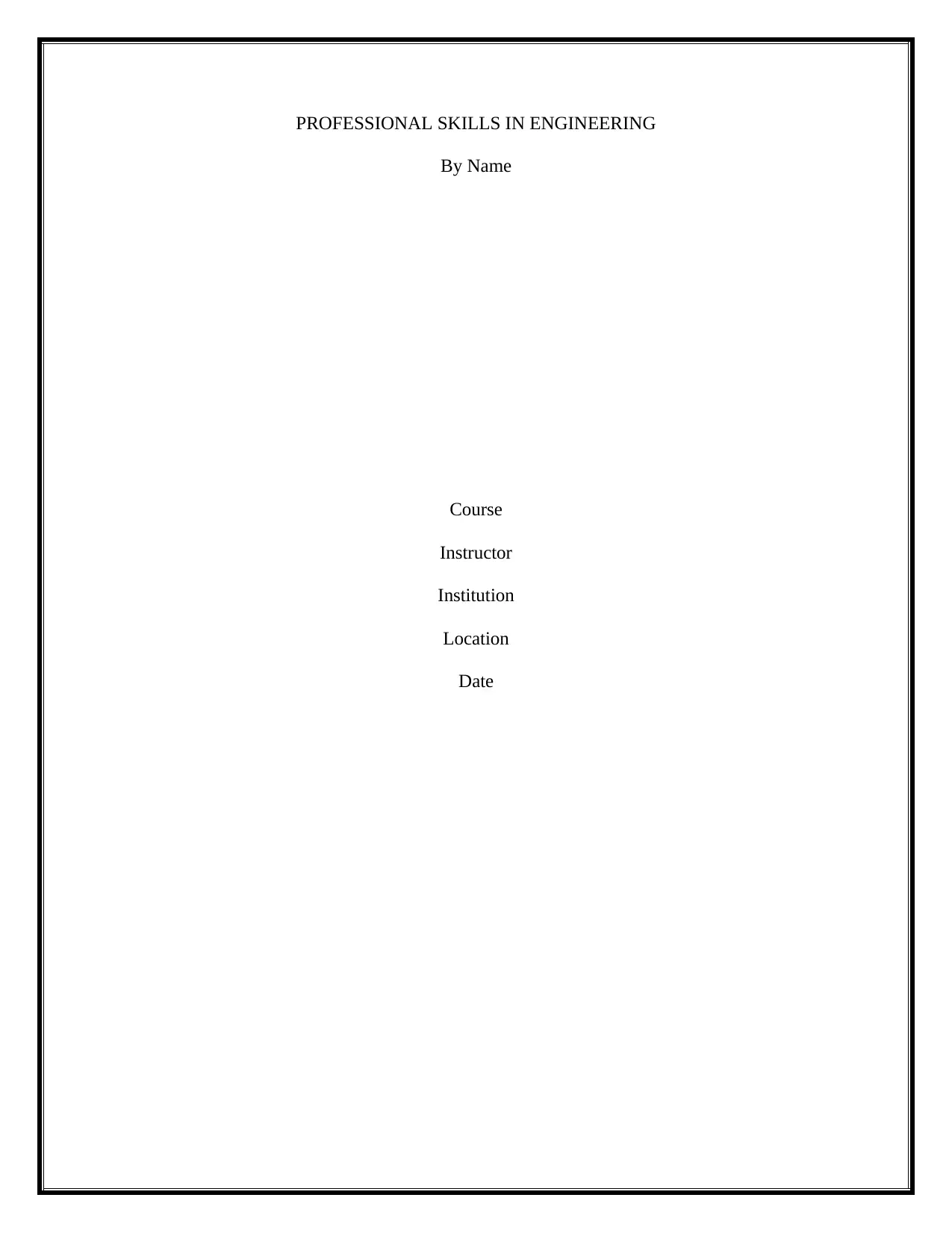
PROFESSIONAL SKILLS IN ENGINEERING
By Name
Course
Instructor
Institution
Location
Date
By Name
Course
Instructor
Institution
Location
Date
Secure Best Marks with AI Grader
Need help grading? Try our AI Grader for instant feedback on your assignments.
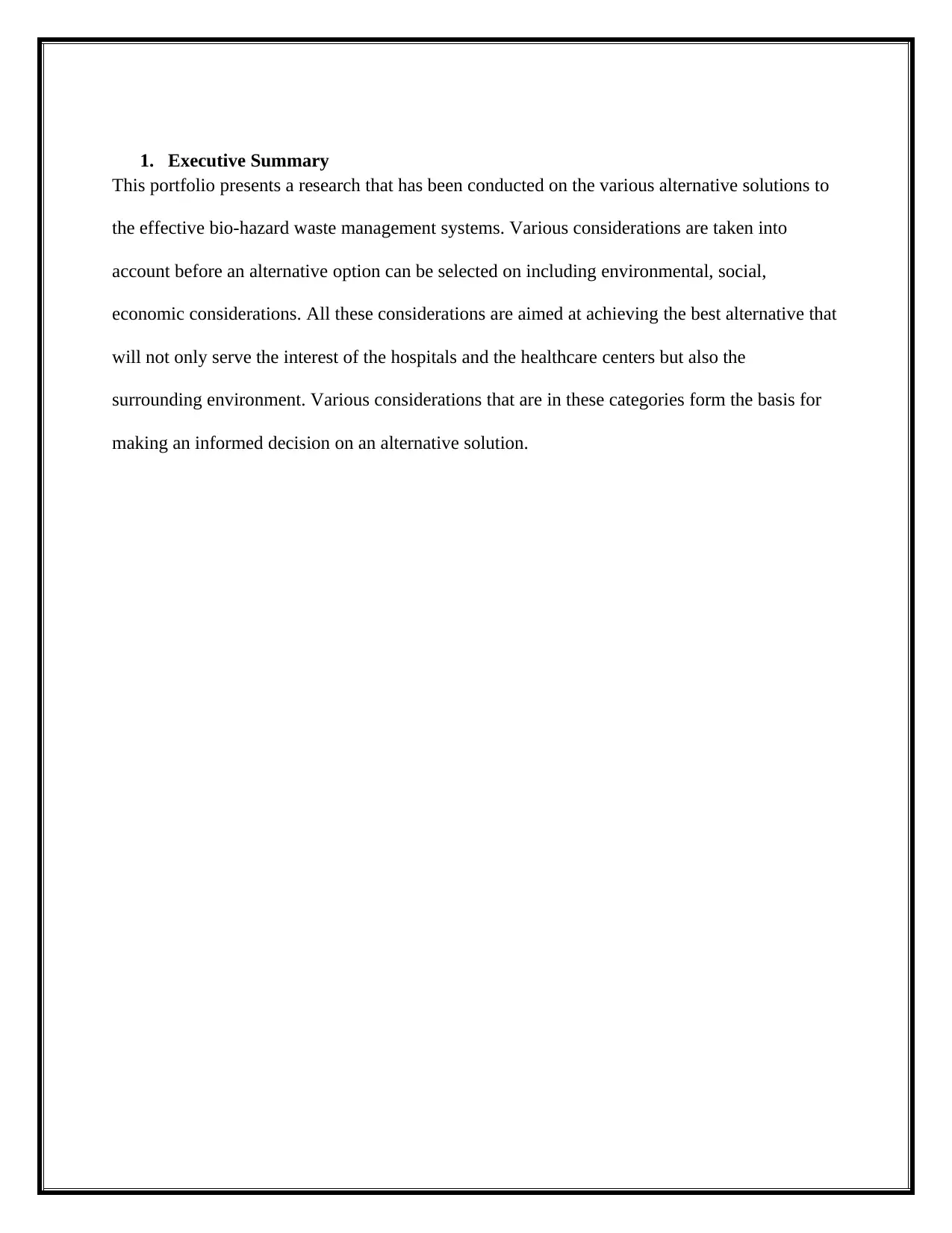
1. Executive Summary
This portfolio presents a research that has been conducted on the various alternative solutions to
the effective bio-hazard waste management systems. Various considerations are taken into
account before an alternative option can be selected on including environmental, social,
economic considerations. All these considerations are aimed at achieving the best alternative that
will not only serve the interest of the hospitals and the healthcare centers but also the
surrounding environment. Various considerations that are in these categories form the basis for
making an informed decision on an alternative solution.
This portfolio presents a research that has been conducted on the various alternative solutions to
the effective bio-hazard waste management systems. Various considerations are taken into
account before an alternative option can be selected on including environmental, social,
economic considerations. All these considerations are aimed at achieving the best alternative that
will not only serve the interest of the hospitals and the healthcare centers but also the
surrounding environment. Various considerations that are in these categories form the basis for
making an informed decision on an alternative solution.
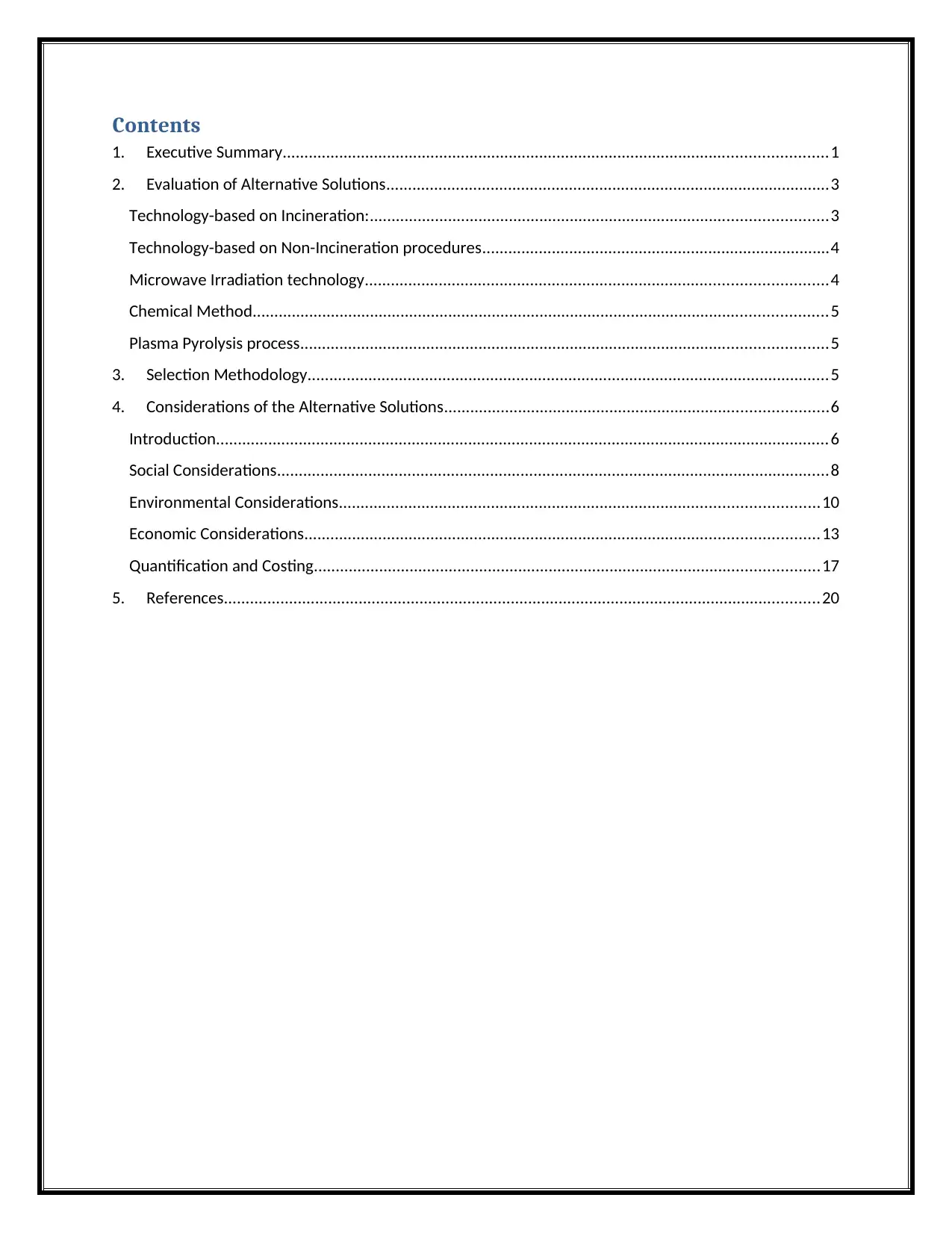
Contents
1. Executive Summary.............................................................................................................................1
2. Evaluation of Alternative Solutions......................................................................................................3
Technology-based on Incineration:.........................................................................................................3
Technology-based on Non-Incineration procedures................................................................................4
Microwave Irradiation technology..........................................................................................................4
Chemical Method....................................................................................................................................5
Plasma Pyrolysis process.........................................................................................................................5
3. Selection Methodology........................................................................................................................5
4. Considerations of the Alternative Solutions........................................................................................6
Introduction.............................................................................................................................................6
Social Considerations...............................................................................................................................8
Environmental Considerations..............................................................................................................10
Economic Considerations......................................................................................................................13
Quantification and Costing....................................................................................................................17
5. References.........................................................................................................................................20
1. Executive Summary.............................................................................................................................1
2. Evaluation of Alternative Solutions......................................................................................................3
Technology-based on Incineration:.........................................................................................................3
Technology-based on Non-Incineration procedures................................................................................4
Microwave Irradiation technology..........................................................................................................4
Chemical Method....................................................................................................................................5
Plasma Pyrolysis process.........................................................................................................................5
3. Selection Methodology........................................................................................................................5
4. Considerations of the Alternative Solutions........................................................................................6
Introduction.............................................................................................................................................6
Social Considerations...............................................................................................................................8
Environmental Considerations..............................................................................................................10
Economic Considerations......................................................................................................................13
Quantification and Costing....................................................................................................................17
5. References.........................................................................................................................................20
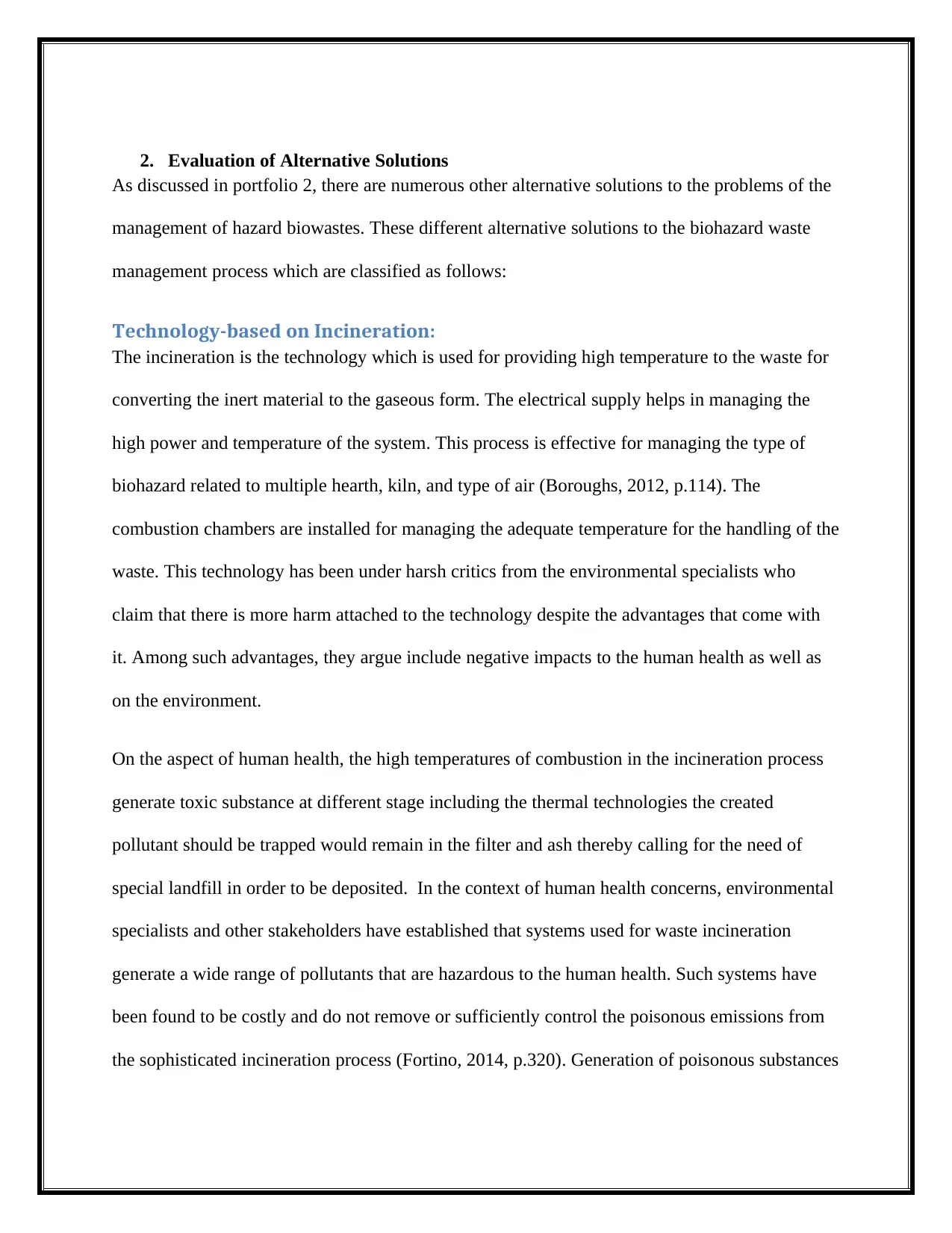
2. Evaluation of Alternative Solutions
As discussed in portfolio 2, there are numerous other alternative solutions to the problems of the
management of hazard biowastes. These different alternative solutions to the biohazard waste
management process which are classified as follows:
Technology-based on Incineration:
The incineration is the technology which is used for providing high temperature to the waste for
converting the inert material to the gaseous form. The electrical supply helps in managing the
high power and temperature of the system. This process is effective for managing the type of
biohazard related to multiple hearth, kiln, and type of air (Boroughs, 2012, p.114). The
combustion chambers are installed for managing the adequate temperature for the handling of the
waste. This technology has been under harsh critics from the environmental specialists who
claim that there is more harm attached to the technology despite the advantages that come with
it. Among such advantages, they argue include negative impacts to the human health as well as
on the environment.
On the aspect of human health, the high temperatures of combustion in the incineration process
generate toxic substance at different stage including the thermal technologies the created
pollutant should be trapped would remain in the filter and ash thereby calling for the need of
special landfill in order to be deposited. In the context of human health concerns, environmental
specialists and other stakeholders have established that systems used for waste incineration
generate a wide range of pollutants that are hazardous to the human health. Such systems have
been found to be costly and do not remove or sufficiently control the poisonous emissions from
the sophisticated incineration process (Fortino, 2014, p.320). Generation of poisonous substances
As discussed in portfolio 2, there are numerous other alternative solutions to the problems of the
management of hazard biowastes. These different alternative solutions to the biohazard waste
management process which are classified as follows:
Technology-based on Incineration:
The incineration is the technology which is used for providing high temperature to the waste for
converting the inert material to the gaseous form. The electrical supply helps in managing the
high power and temperature of the system. This process is effective for managing the type of
biohazard related to multiple hearth, kiln, and type of air (Boroughs, 2012, p.114). The
combustion chambers are installed for managing the adequate temperature for the handling of the
waste. This technology has been under harsh critics from the environmental specialists who
claim that there is more harm attached to the technology despite the advantages that come with
it. Among such advantages, they argue include negative impacts to the human health as well as
on the environment.
On the aspect of human health, the high temperatures of combustion in the incineration process
generate toxic substance at different stage including the thermal technologies the created
pollutant should be trapped would remain in the filter and ash thereby calling for the need of
special landfill in order to be deposited. In the context of human health concerns, environmental
specialists and other stakeholders have established that systems used for waste incineration
generate a wide range of pollutants that are hazardous to the human health. Such systems have
been found to be costly and do not remove or sufficiently control the poisonous emissions from
the sophisticated incineration process (Fortino, 2014, p.320). Generation of poisonous substances
Secure Best Marks with AI Grader
Need help grading? Try our AI Grader for instant feedback on your assignments.
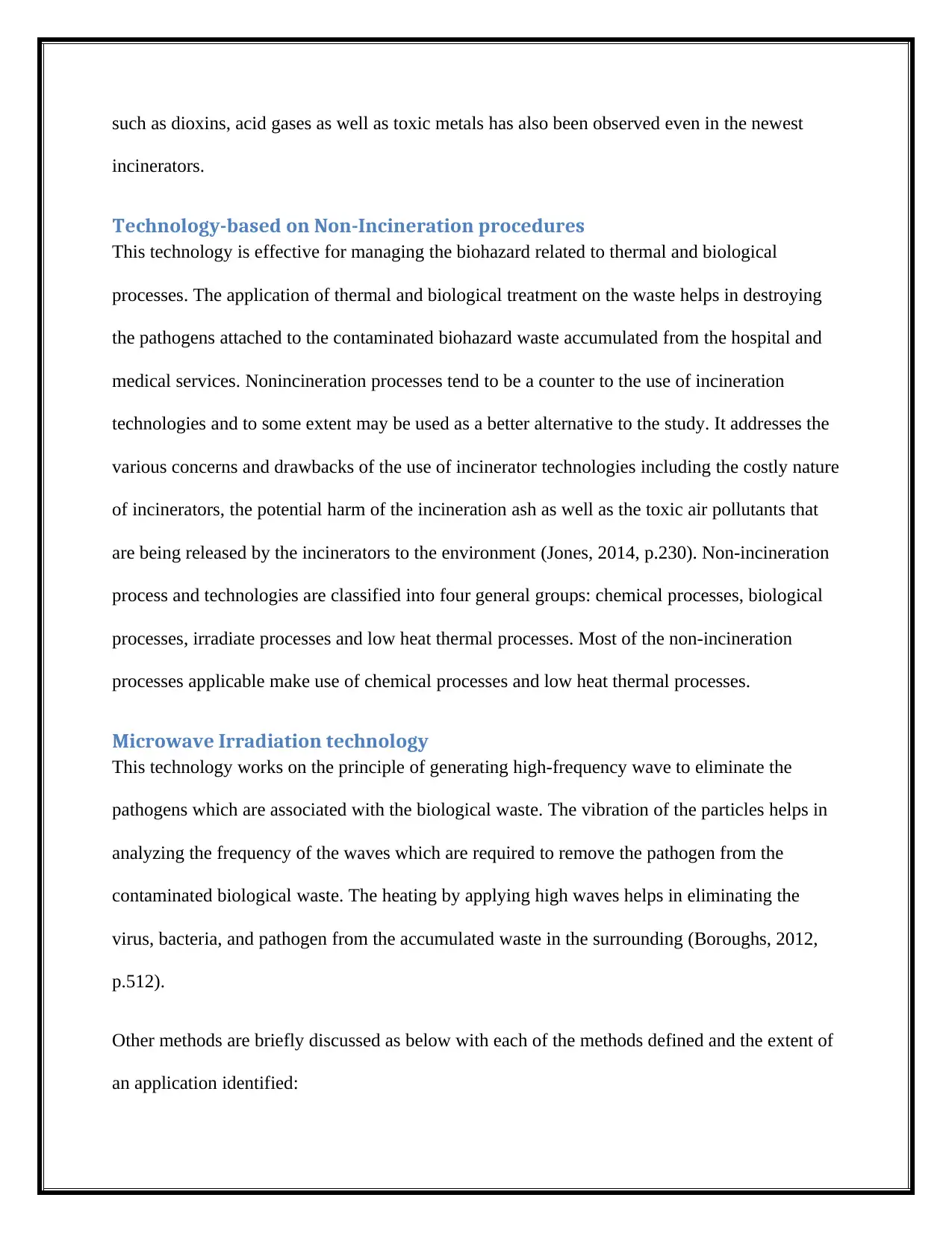
such as dioxins, acid gases as well as toxic metals has also been observed even in the newest
incinerators.
Technology-based on Non-Incineration procedures
This technology is effective for managing the biohazard related to thermal and biological
processes. The application of thermal and biological treatment on the waste helps in destroying
the pathogens attached to the contaminated biohazard waste accumulated from the hospital and
medical services. Nonincineration processes tend to be a counter to the use of incineration
technologies and to some extent may be used as a better alternative to the study. It addresses the
various concerns and drawbacks of the use of incinerator technologies including the costly nature
of incinerators, the potential harm of the incineration ash as well as the toxic air pollutants that
are being released by the incinerators to the environment (Jones, 2014, p.230). Non-incineration
process and technologies are classified into four general groups: chemical processes, biological
processes, irradiate processes and low heat thermal processes. Most of the non-incineration
processes applicable make use of chemical processes and low heat thermal processes.
Microwave Irradiation technology
This technology works on the principle of generating high-frequency wave to eliminate the
pathogens which are associated with the biological waste. The vibration of the particles helps in
analyzing the frequency of the waves which are required to remove the pathogen from the
contaminated biological waste. The heating by applying high waves helps in eliminating the
virus, bacteria, and pathogen from the accumulated waste in the surrounding (Boroughs, 2012,
p.512).
Other methods are briefly discussed as below with each of the methods defined and the extent of
an application identified:
incinerators.
Technology-based on Non-Incineration procedures
This technology is effective for managing the biohazard related to thermal and biological
processes. The application of thermal and biological treatment on the waste helps in destroying
the pathogens attached to the contaminated biohazard waste accumulated from the hospital and
medical services. Nonincineration processes tend to be a counter to the use of incineration
technologies and to some extent may be used as a better alternative to the study. It addresses the
various concerns and drawbacks of the use of incinerator technologies including the costly nature
of incinerators, the potential harm of the incineration ash as well as the toxic air pollutants that
are being released by the incinerators to the environment (Jones, 2014, p.230). Non-incineration
process and technologies are classified into four general groups: chemical processes, biological
processes, irradiate processes and low heat thermal processes. Most of the non-incineration
processes applicable make use of chemical processes and low heat thermal processes.
Microwave Irradiation technology
This technology works on the principle of generating high-frequency wave to eliminate the
pathogens which are associated with the biological waste. The vibration of the particles helps in
analyzing the frequency of the waves which are required to remove the pathogen from the
contaminated biological waste. The heating by applying high waves helps in eliminating the
virus, bacteria, and pathogen from the accumulated waste in the surrounding (Boroughs, 2012,
p.512).
Other methods are briefly discussed as below with each of the methods defined and the extent of
an application identified:
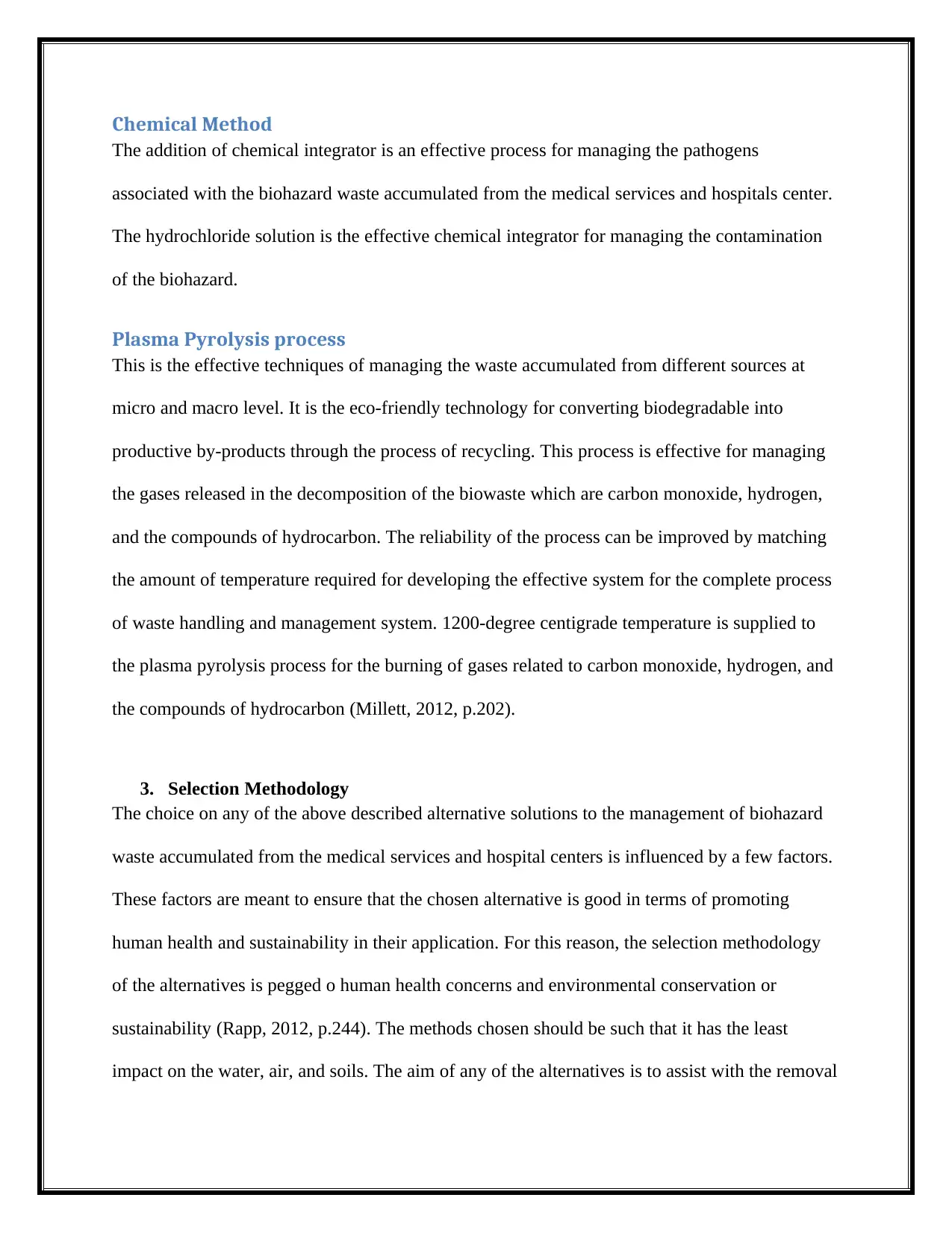
Chemical Method
The addition of chemical integrator is an effective process for managing the pathogens
associated with the biohazard waste accumulated from the medical services and hospitals center.
The hydrochloride solution is the effective chemical integrator for managing the contamination
of the biohazard.
Plasma Pyrolysis process
This is the effective techniques of managing the waste accumulated from different sources at
micro and macro level. It is the eco-friendly technology for converting biodegradable into
productive by-products through the process of recycling. This process is effective for managing
the gases released in the decomposition of the biowaste which are carbon monoxide, hydrogen,
and the compounds of hydrocarbon. The reliability of the process can be improved by matching
the amount of temperature required for developing the effective system for the complete process
of waste handling and management system. 1200-degree centigrade temperature is supplied to
the plasma pyrolysis process for the burning of gases related to carbon monoxide, hydrogen, and
the compounds of hydrocarbon (Millett, 2012, p.202).
3. Selection Methodology
The choice on any of the above described alternative solutions to the management of biohazard
waste accumulated from the medical services and hospital centers is influenced by a few factors.
These factors are meant to ensure that the chosen alternative is good in terms of promoting
human health and sustainability in their application. For this reason, the selection methodology
of the alternatives is pegged o human health concerns and environmental conservation or
sustainability (Rapp, 2012, p.244). The methods chosen should be such that it has the least
impact on the water, air, and soils. The aim of any of the alternatives is to assist with the removal
The addition of chemical integrator is an effective process for managing the pathogens
associated with the biohazard waste accumulated from the medical services and hospitals center.
The hydrochloride solution is the effective chemical integrator for managing the contamination
of the biohazard.
Plasma Pyrolysis process
This is the effective techniques of managing the waste accumulated from different sources at
micro and macro level. It is the eco-friendly technology for converting biodegradable into
productive by-products through the process of recycling. This process is effective for managing
the gases released in the decomposition of the biowaste which are carbon monoxide, hydrogen,
and the compounds of hydrocarbon. The reliability of the process can be improved by matching
the amount of temperature required for developing the effective system for the complete process
of waste handling and management system. 1200-degree centigrade temperature is supplied to
the plasma pyrolysis process for the burning of gases related to carbon monoxide, hydrogen, and
the compounds of hydrocarbon (Millett, 2012, p.202).
3. Selection Methodology
The choice on any of the above described alternative solutions to the management of biohazard
waste accumulated from the medical services and hospital centers is influenced by a few factors.
These factors are meant to ensure that the chosen alternative is good in terms of promoting
human health and sustainability in their application. For this reason, the selection methodology
of the alternatives is pegged o human health concerns and environmental conservation or
sustainability (Rapp, 2012, p.244). The methods chosen should be such that it has the least
impact on the water, air, and soils. The aim of any of the alternatives is to assist with the removal
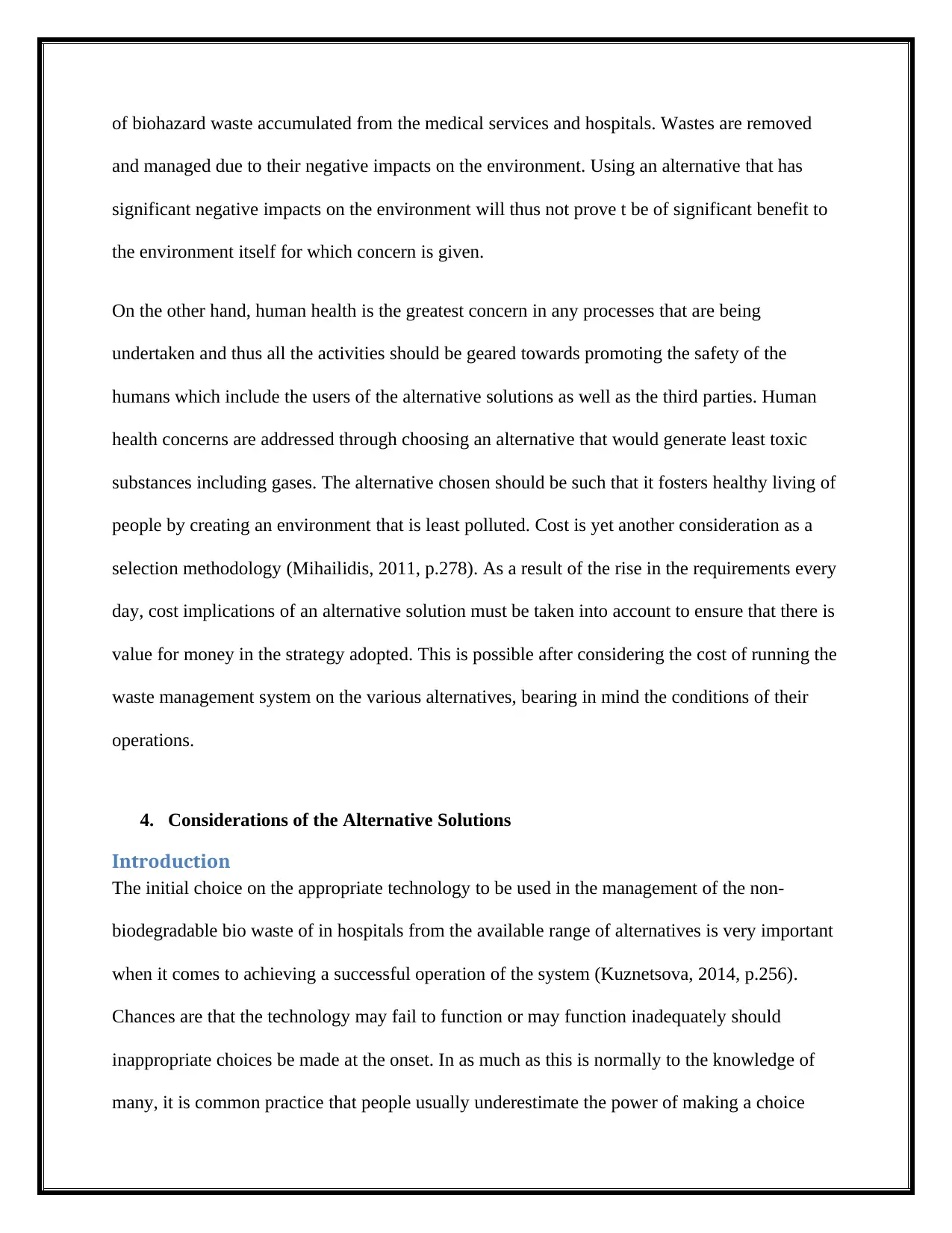
of biohazard waste accumulated from the medical services and hospitals. Wastes are removed
and managed due to their negative impacts on the environment. Using an alternative that has
significant negative impacts on the environment will thus not prove t be of significant benefit to
the environment itself for which concern is given.
On the other hand, human health is the greatest concern in any processes that are being
undertaken and thus all the activities should be geared towards promoting the safety of the
humans which include the users of the alternative solutions as well as the third parties. Human
health concerns are addressed through choosing an alternative that would generate least toxic
substances including gases. The alternative chosen should be such that it fosters healthy living of
people by creating an environment that is least polluted. Cost is yet another consideration as a
selection methodology (Mihailidis, 2011, p.278). As a result of the rise in the requirements every
day, cost implications of an alternative solution must be taken into account to ensure that there is
value for money in the strategy adopted. This is possible after considering the cost of running the
waste management system on the various alternatives, bearing in mind the conditions of their
operations.
4. Considerations of the Alternative Solutions
Introduction
The initial choice on the appropriate technology to be used in the management of the non-
biodegradable bio waste of in hospitals from the available range of alternatives is very important
when it comes to achieving a successful operation of the system (Kuznetsova, 2014, p.256).
Chances are that the technology may fail to function or may function inadequately should
inappropriate choices be made at the onset. In as much as this is normally to the knowledge of
many, it is common practice that people usually underestimate the power of making a choice
and managed due to their negative impacts on the environment. Using an alternative that has
significant negative impacts on the environment will thus not prove t be of significant benefit to
the environment itself for which concern is given.
On the other hand, human health is the greatest concern in any processes that are being
undertaken and thus all the activities should be geared towards promoting the safety of the
humans which include the users of the alternative solutions as well as the third parties. Human
health concerns are addressed through choosing an alternative that would generate least toxic
substances including gases. The alternative chosen should be such that it fosters healthy living of
people by creating an environment that is least polluted. Cost is yet another consideration as a
selection methodology (Mihailidis, 2011, p.278). As a result of the rise in the requirements every
day, cost implications of an alternative solution must be taken into account to ensure that there is
value for money in the strategy adopted. This is possible after considering the cost of running the
waste management system on the various alternatives, bearing in mind the conditions of their
operations.
4. Considerations of the Alternative Solutions
Introduction
The initial choice on the appropriate technology to be used in the management of the non-
biodegradable bio waste of in hospitals from the available range of alternatives is very important
when it comes to achieving a successful operation of the system (Kuznetsova, 2014, p.256).
Chances are that the technology may fail to function or may function inadequately should
inappropriate choices be made at the onset. In as much as this is normally to the knowledge of
many, it is common practice that people usually underestimate the power of making a choice
Paraphrase This Document
Need a fresh take? Get an instant paraphrase of this document with our AI Paraphraser

based on numerous available alternative and considerations that need to be taken into
consideration.
The waste management alternatives available may not be appropriate in all the places and with
all the users owing to a number of factors. This raises the need to come up with the
considerations that when given attention will; ensure that the most appropriate choice is made.
There are three selection stages that are involved in the considerations: objectives, analysis, and
output. The objective stage identifies the purpose of non-biodegradable bio-waste management
in hospitals and other health facilities (Purnendu, 2013, p.315). The stage attempts to offer
responses to these questions what achievement is being attempted and why. Other questions that
this objective will address include if the objective is achievable as well as identifying if the
attempted achievement is the main problem. More often than not, numerous people
underestimate this stage. The priority in this project should be low-cost, sustainable and effective
waste management system of non-biodegradable bio wastes.
The second stage is about the limitations of the proposed development. This is only a possibility
of taking a lot at the particularities of each of the individual cases. In most cases, physical
constraints among the availability of land and water resources are normally considered. It is
important to consider all the fundamental factors that have the potential to significantly
contribute to the failure or success of the scheme to be addressed in an elaborate manner. For the
purposes of analysis, the issues are classified into SHTEFIE criteria, criteria that were developed
by Richard Franceys and Margaret among other at WEDC as a tool to aid in the analysis of the
programs of development (Light, 2011, p.121).
S-Social
consideration.
The waste management alternatives available may not be appropriate in all the places and with
all the users owing to a number of factors. This raises the need to come up with the
considerations that when given attention will; ensure that the most appropriate choice is made.
There are three selection stages that are involved in the considerations: objectives, analysis, and
output. The objective stage identifies the purpose of non-biodegradable bio-waste management
in hospitals and other health facilities (Purnendu, 2013, p.315). The stage attempts to offer
responses to these questions what achievement is being attempted and why. Other questions that
this objective will address include if the objective is achievable as well as identifying if the
attempted achievement is the main problem. More often than not, numerous people
underestimate this stage. The priority in this project should be low-cost, sustainable and effective
waste management system of non-biodegradable bio wastes.
The second stage is about the limitations of the proposed development. This is only a possibility
of taking a lot at the particularities of each of the individual cases. In most cases, physical
constraints among the availability of land and water resources are normally considered. It is
important to consider all the fundamental factors that have the potential to significantly
contribute to the failure or success of the scheme to be addressed in an elaborate manner. For the
purposes of analysis, the issues are classified into SHTEFIE criteria, criteria that were developed
by Richard Franceys and Margaret among other at WEDC as a tool to aid in the analysis of the
programs of development (Light, 2011, p.121).
S-Social
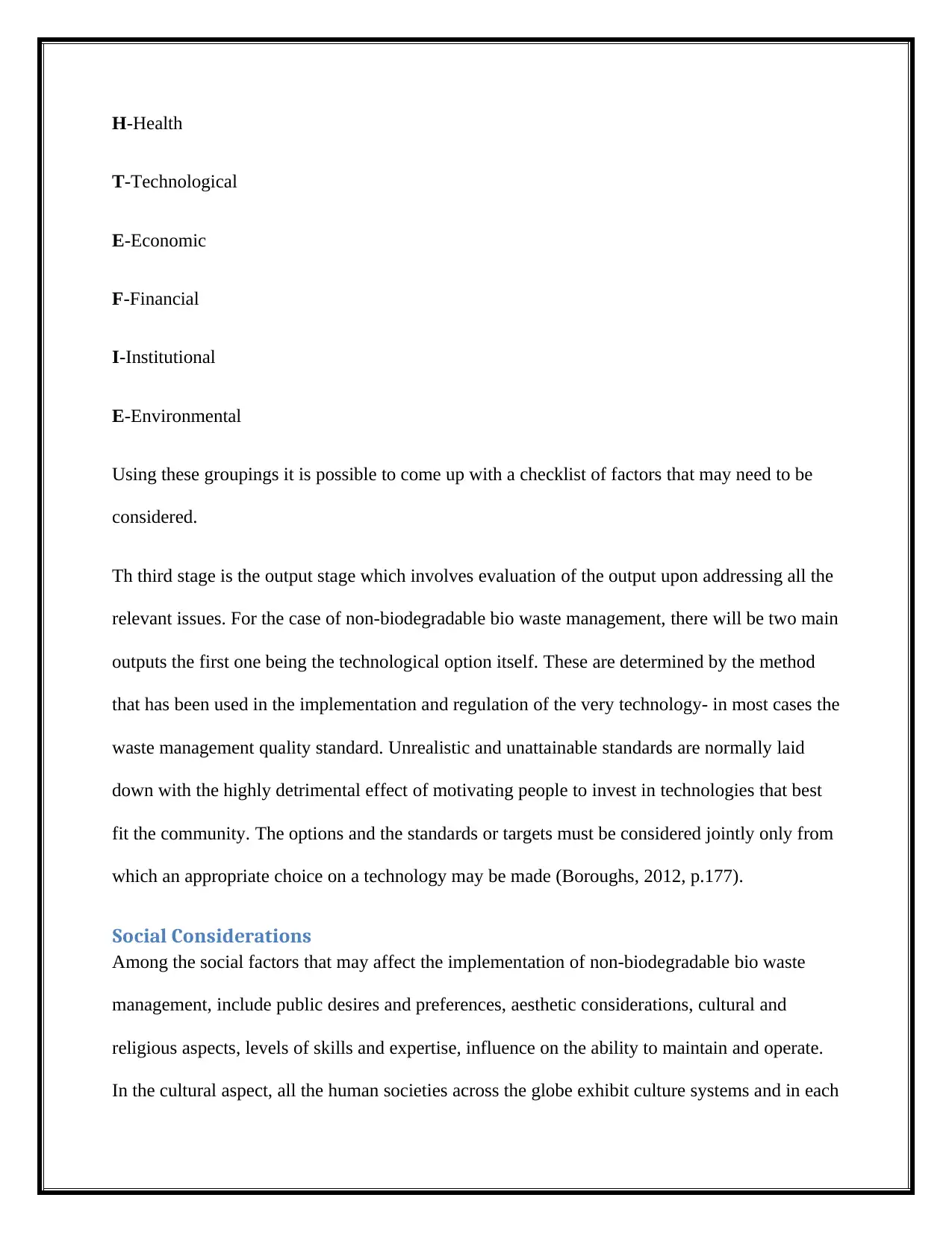
H-Health
T-Technological
E-Economic
F-Financial
I-Institutional
E-Environmental
Using these groupings it is possible to come up with a checklist of factors that may need to be
considered.
Th third stage is the output stage which involves evaluation of the output upon addressing all the
relevant issues. For the case of non-biodegradable bio waste management, there will be two main
outputs the first one being the technological option itself. These are determined by the method
that has been used in the implementation and regulation of the very technology- in most cases the
waste management quality standard. Unrealistic and unattainable standards are normally laid
down with the highly detrimental effect of motivating people to invest in technologies that best
fit the community. The options and the standards or targets must be considered jointly only from
which an appropriate choice on a technology may be made (Boroughs, 2012, p.177).
Social Considerations
Among the social factors that may affect the implementation of non-biodegradable bio waste
management, include public desires and preferences, aesthetic considerations, cultural and
religious aspects, levels of skills and expertise, influence on the ability to maintain and operate.
In the cultural aspect, all the human societies across the globe exhibit culture systems and in each
T-Technological
E-Economic
F-Financial
I-Institutional
E-Environmental
Using these groupings it is possible to come up with a checklist of factors that may need to be
considered.
Th third stage is the output stage which involves evaluation of the output upon addressing all the
relevant issues. For the case of non-biodegradable bio waste management, there will be two main
outputs the first one being the technological option itself. These are determined by the method
that has been used in the implementation and regulation of the very technology- in most cases the
waste management quality standard. Unrealistic and unattainable standards are normally laid
down with the highly detrimental effect of motivating people to invest in technologies that best
fit the community. The options and the standards or targets must be considered jointly only from
which an appropriate choice on a technology may be made (Boroughs, 2012, p.177).
Social Considerations
Among the social factors that may affect the implementation of non-biodegradable bio waste
management, include public desires and preferences, aesthetic considerations, cultural and
religious aspects, levels of skills and expertise, influence on the ability to maintain and operate.
In the cultural aspect, all the human societies across the globe exhibit culture systems and in each
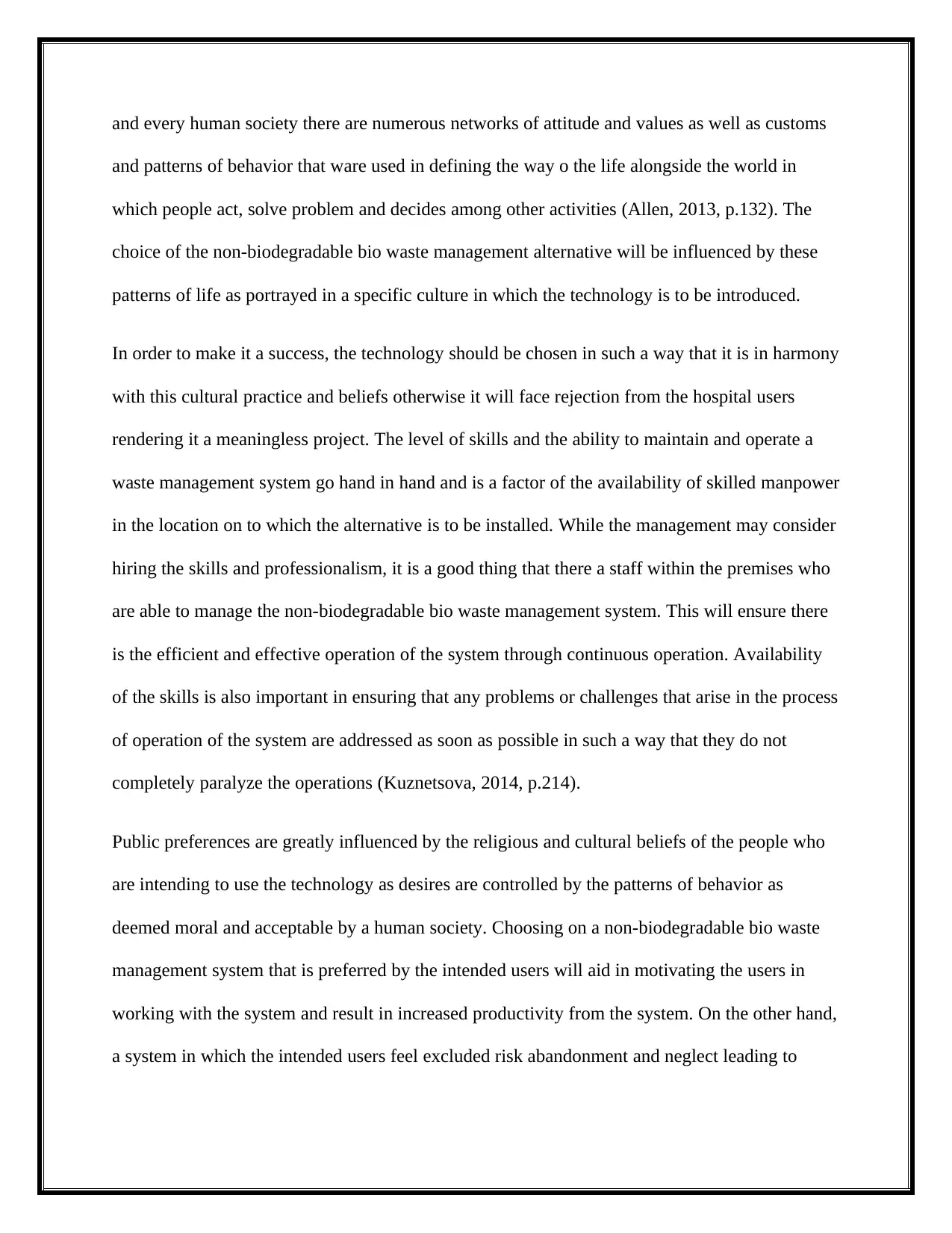
and every human society there are numerous networks of attitude and values as well as customs
and patterns of behavior that ware used in defining the way o the life alongside the world in
which people act, solve problem and decides among other activities (Allen, 2013, p.132). The
choice of the non-biodegradable bio waste management alternative will be influenced by these
patterns of life as portrayed in a specific culture in which the technology is to be introduced.
In order to make it a success, the technology should be chosen in such a way that it is in harmony
with this cultural practice and beliefs otherwise it will face rejection from the hospital users
rendering it a meaningless project. The level of skills and the ability to maintain and operate a
waste management system go hand in hand and is a factor of the availability of skilled manpower
in the location on to which the alternative is to be installed. While the management may consider
hiring the skills and professionalism, it is a good thing that there a staff within the premises who
are able to manage the non-biodegradable bio waste management system. This will ensure there
is the efficient and effective operation of the system through continuous operation. Availability
of the skills is also important in ensuring that any problems or challenges that arise in the process
of operation of the system are addressed as soon as possible in such a way that they do not
completely paralyze the operations (Kuznetsova, 2014, p.214).
Public preferences are greatly influenced by the religious and cultural beliefs of the people who
are intending to use the technology as desires are controlled by the patterns of behavior as
deemed moral and acceptable by a human society. Choosing on a non-biodegradable bio waste
management system that is preferred by the intended users will aid in motivating the users in
working with the system and result in increased productivity from the system. On the other hand,
a system in which the intended users feel excluded risk abandonment and neglect leading to
and patterns of behavior that ware used in defining the way o the life alongside the world in
which people act, solve problem and decides among other activities (Allen, 2013, p.132). The
choice of the non-biodegradable bio waste management alternative will be influenced by these
patterns of life as portrayed in a specific culture in which the technology is to be introduced.
In order to make it a success, the technology should be chosen in such a way that it is in harmony
with this cultural practice and beliefs otherwise it will face rejection from the hospital users
rendering it a meaningless project. The level of skills and the ability to maintain and operate a
waste management system go hand in hand and is a factor of the availability of skilled manpower
in the location on to which the alternative is to be installed. While the management may consider
hiring the skills and professionalism, it is a good thing that there a staff within the premises who
are able to manage the non-biodegradable bio waste management system. This will ensure there
is the efficient and effective operation of the system through continuous operation. Availability
of the skills is also important in ensuring that any problems or challenges that arise in the process
of operation of the system are addressed as soon as possible in such a way that they do not
completely paralyze the operations (Kuznetsova, 2014, p.214).
Public preferences are greatly influenced by the religious and cultural beliefs of the people who
are intending to use the technology as desires are controlled by the patterns of behavior as
deemed moral and acceptable by a human society. Choosing on a non-biodegradable bio waste
management system that is preferred by the intended users will aid in motivating the users in
working with the system and result in increased productivity from the system. On the other hand,
a system in which the intended users feel excluded risk abandonment and neglect leading to
Secure Best Marks with AI Grader
Need help grading? Try our AI Grader for instant feedback on your assignments.
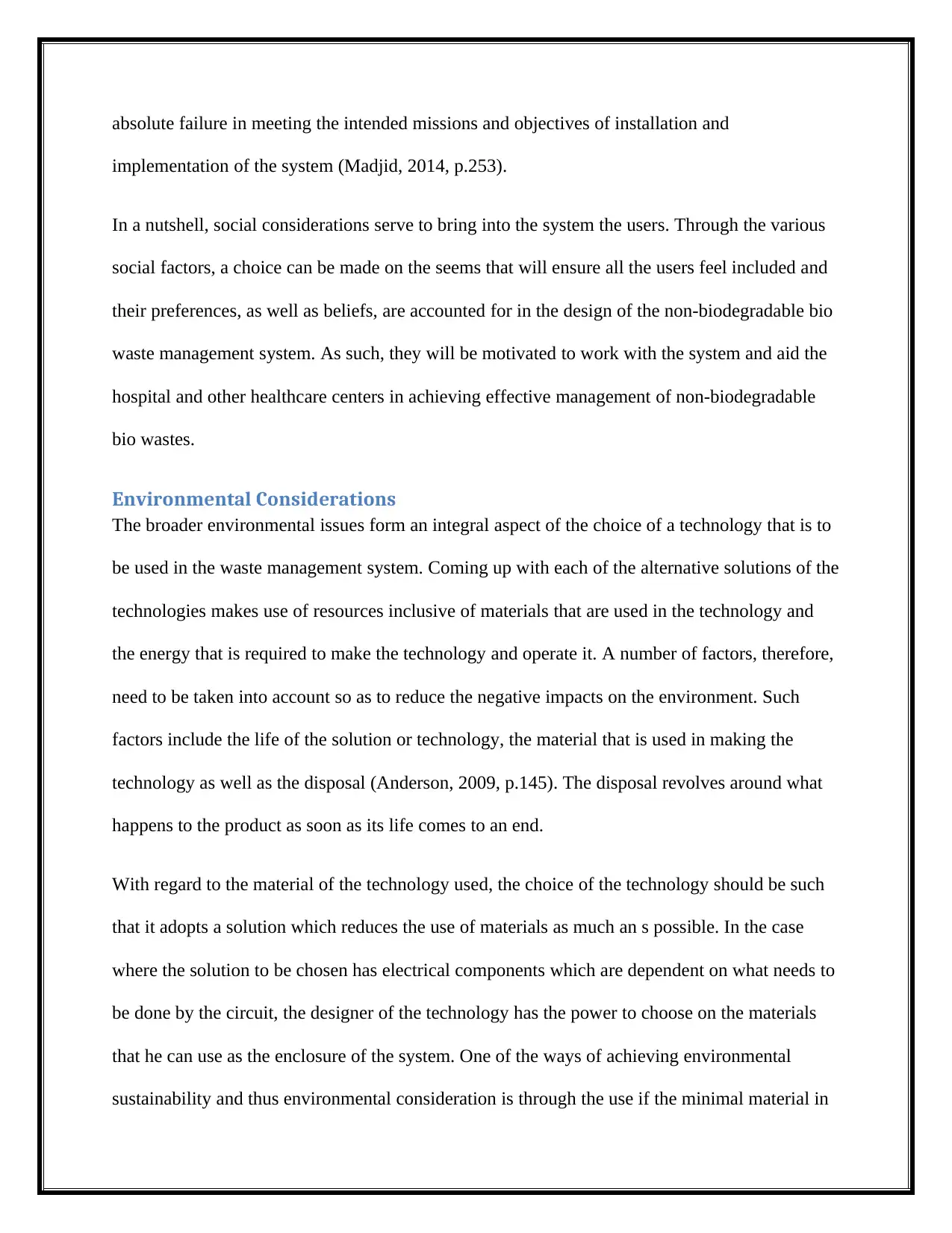
absolute failure in meeting the intended missions and objectives of installation and
implementation of the system (Madjid, 2014, p.253).
In a nutshell, social considerations serve to bring into the system the users. Through the various
social factors, a choice can be made on the seems that will ensure all the users feel included and
their preferences, as well as beliefs, are accounted for in the design of the non-biodegradable bio
waste management system. As such, they will be motivated to work with the system and aid the
hospital and other healthcare centers in achieving effective management of non-biodegradable
bio wastes.
Environmental Considerations
The broader environmental issues form an integral aspect of the choice of a technology that is to
be used in the waste management system. Coming up with each of the alternative solutions of the
technologies makes use of resources inclusive of materials that are used in the technology and
the energy that is required to make the technology and operate it. A number of factors, therefore,
need to be taken into account so as to reduce the negative impacts on the environment. Such
factors include the life of the solution or technology, the material that is used in making the
technology as well as the disposal (Anderson, 2009, p.145). The disposal revolves around what
happens to the product as soon as its life comes to an end.
With regard to the material of the technology used, the choice of the technology should be such
that it adopts a solution which reduces the use of materials as much an s possible. In the case
where the solution to be chosen has electrical components which are dependent on what needs to
be done by the circuit, the designer of the technology has the power to choose on the materials
that he can use as the enclosure of the system. One of the ways of achieving environmental
sustainability and thus environmental consideration is through the use if the minimal material in
implementation of the system (Madjid, 2014, p.253).
In a nutshell, social considerations serve to bring into the system the users. Through the various
social factors, a choice can be made on the seems that will ensure all the users feel included and
their preferences, as well as beliefs, are accounted for in the design of the non-biodegradable bio
waste management system. As such, they will be motivated to work with the system and aid the
hospital and other healthcare centers in achieving effective management of non-biodegradable
bio wastes.
Environmental Considerations
The broader environmental issues form an integral aspect of the choice of a technology that is to
be used in the waste management system. Coming up with each of the alternative solutions of the
technologies makes use of resources inclusive of materials that are used in the technology and
the energy that is required to make the technology and operate it. A number of factors, therefore,
need to be taken into account so as to reduce the negative impacts on the environment. Such
factors include the life of the solution or technology, the material that is used in making the
technology as well as the disposal (Anderson, 2009, p.145). The disposal revolves around what
happens to the product as soon as its life comes to an end.
With regard to the material of the technology used, the choice of the technology should be such
that it adopts a solution which reduces the use of materials as much an s possible. In the case
where the solution to be chosen has electrical components which are dependent on what needs to
be done by the circuit, the designer of the technology has the power to choose on the materials
that he can use as the enclosure of the system. One of the ways of achieving environmental
sustainability and thus environmental consideration is through the use if the minimal material in
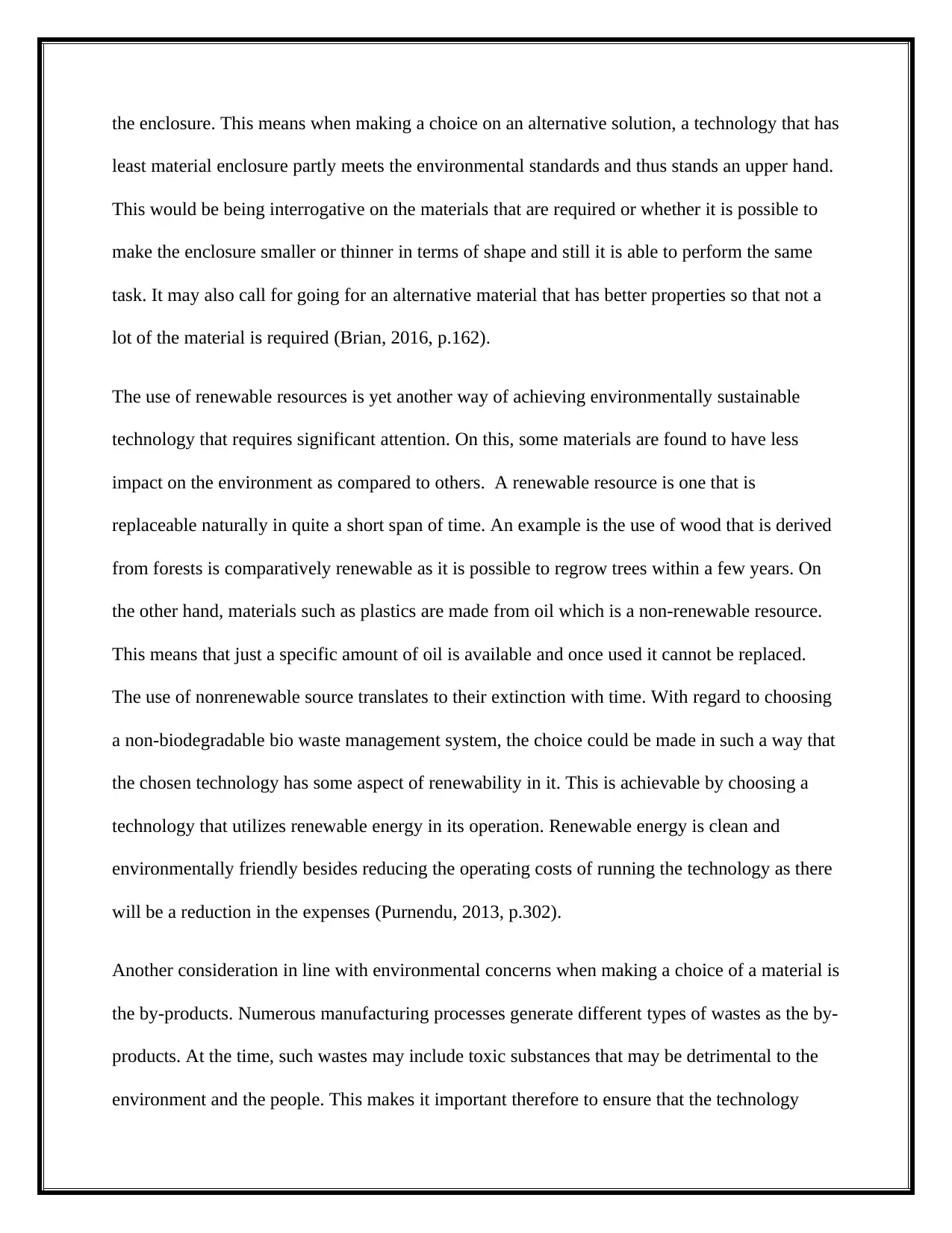
the enclosure. This means when making a choice on an alternative solution, a technology that has
least material enclosure partly meets the environmental standards and thus stands an upper hand.
This would be being interrogative on the materials that are required or whether it is possible to
make the enclosure smaller or thinner in terms of shape and still it is able to perform the same
task. It may also call for going for an alternative material that has better properties so that not a
lot of the material is required (Brian, 2016, p.162).
The use of renewable resources is yet another way of achieving environmentally sustainable
technology that requires significant attention. On this, some materials are found to have less
impact on the environment as compared to others. A renewable resource is one that is
replaceable naturally in quite a short span of time. An example is the use of wood that is derived
from forests is comparatively renewable as it is possible to regrow trees within a few years. On
the other hand, materials such as plastics are made from oil which is a non-renewable resource.
This means that just a specific amount of oil is available and once used it cannot be replaced.
The use of nonrenewable source translates to their extinction with time. With regard to choosing
a non-biodegradable bio waste management system, the choice could be made in such a way that
the chosen technology has some aspect of renewability in it. This is achievable by choosing a
technology that utilizes renewable energy in its operation. Renewable energy is clean and
environmentally friendly besides reducing the operating costs of running the technology as there
will be a reduction in the expenses (Purnendu, 2013, p.302).
Another consideration in line with environmental concerns when making a choice of a material is
the by-products. Numerous manufacturing processes generate different types of wastes as the by-
products. At the time, such wastes may include toxic substances that may be detrimental to the
environment and the people. This makes it important therefore to ensure that the technology
least material enclosure partly meets the environmental standards and thus stands an upper hand.
This would be being interrogative on the materials that are required or whether it is possible to
make the enclosure smaller or thinner in terms of shape and still it is able to perform the same
task. It may also call for going for an alternative material that has better properties so that not a
lot of the material is required (Brian, 2016, p.162).
The use of renewable resources is yet another way of achieving environmentally sustainable
technology that requires significant attention. On this, some materials are found to have less
impact on the environment as compared to others. A renewable resource is one that is
replaceable naturally in quite a short span of time. An example is the use of wood that is derived
from forests is comparatively renewable as it is possible to regrow trees within a few years. On
the other hand, materials such as plastics are made from oil which is a non-renewable resource.
This means that just a specific amount of oil is available and once used it cannot be replaced.
The use of nonrenewable source translates to their extinction with time. With regard to choosing
a non-biodegradable bio waste management system, the choice could be made in such a way that
the chosen technology has some aspect of renewability in it. This is achievable by choosing a
technology that utilizes renewable energy in its operation. Renewable energy is clean and
environmentally friendly besides reducing the operating costs of running the technology as there
will be a reduction in the expenses (Purnendu, 2013, p.302).
Another consideration in line with environmental concerns when making a choice of a material is
the by-products. Numerous manufacturing processes generate different types of wastes as the by-
products. At the time, such wastes may include toxic substances that may be detrimental to the
environment and the people. This makes it important therefore to ensure that the technology

solution to the non-biodegradable bio waste management system is chosen in such a way that
consideration is given to how the technology system has been made and any by-products that
may be generated by the processes (Services, 2012, p.218).
In terms of the life of the technology, in most cases, the design of technology is made with
anticipating that it will last for long before they can become non-operational, worn out and
dumped. How long the technology or solution is chosen will last informs an integral aspect of
environmental consideration. A solution with a longer lifespan will ensure that there are just but
a few materials that are required for replacements of the various components of the system. In
order to pick on a solution with a longer lifespan, consideration should be on the materials that
have better properties for example by adopting stronger materials or material that are able to
resist corrosion (Brian, 2016, p.201).
Still, another way of ensuring that an environmentally sustainable solution is settled on is
through picking on a solution whose design allows an extension of the lifespan through
maintenance. Maintenance basically means any undertaking that increases the life of a product or
technology and may include anything other than repair of worn out parts to the replacement of
dead batteries. A solution that is designed in a manner that permits maintenance is one that is
inclusive of features that allow easy replacement of parts (Madjid, 2014, p.148). On the other
hand, the solution may be a series of standardized modules such that if anything goes working in
the system, only the module that is affected is to be removed or repaired as opposed to replacing
or repairing the whole system.
The disposal of the solution or technology upon expiry is yet another environmental
consideration. Each of the solution options has an end and thus will need to be taken through
consideration is given to how the technology system has been made and any by-products that
may be generated by the processes (Services, 2012, p.218).
In terms of the life of the technology, in most cases, the design of technology is made with
anticipating that it will last for long before they can become non-operational, worn out and
dumped. How long the technology or solution is chosen will last informs an integral aspect of
environmental consideration. A solution with a longer lifespan will ensure that there are just but
a few materials that are required for replacements of the various components of the system. In
order to pick on a solution with a longer lifespan, consideration should be on the materials that
have better properties for example by adopting stronger materials or material that are able to
resist corrosion (Brian, 2016, p.201).
Still, another way of ensuring that an environmentally sustainable solution is settled on is
through picking on a solution whose design allows an extension of the lifespan through
maintenance. Maintenance basically means any undertaking that increases the life of a product or
technology and may include anything other than repair of worn out parts to the replacement of
dead batteries. A solution that is designed in a manner that permits maintenance is one that is
inclusive of features that allow easy replacement of parts (Madjid, 2014, p.148). On the other
hand, the solution may be a series of standardized modules such that if anything goes working in
the system, only the module that is affected is to be removed or repaired as opposed to replacing
or repairing the whole system.
The disposal of the solution or technology upon expiry is yet another environmental
consideration. Each of the solution options has an end and thus will need to be taken through
Paraphrase This Document
Need a fresh take? Get an instant paraphrase of this document with our AI Paraphraser
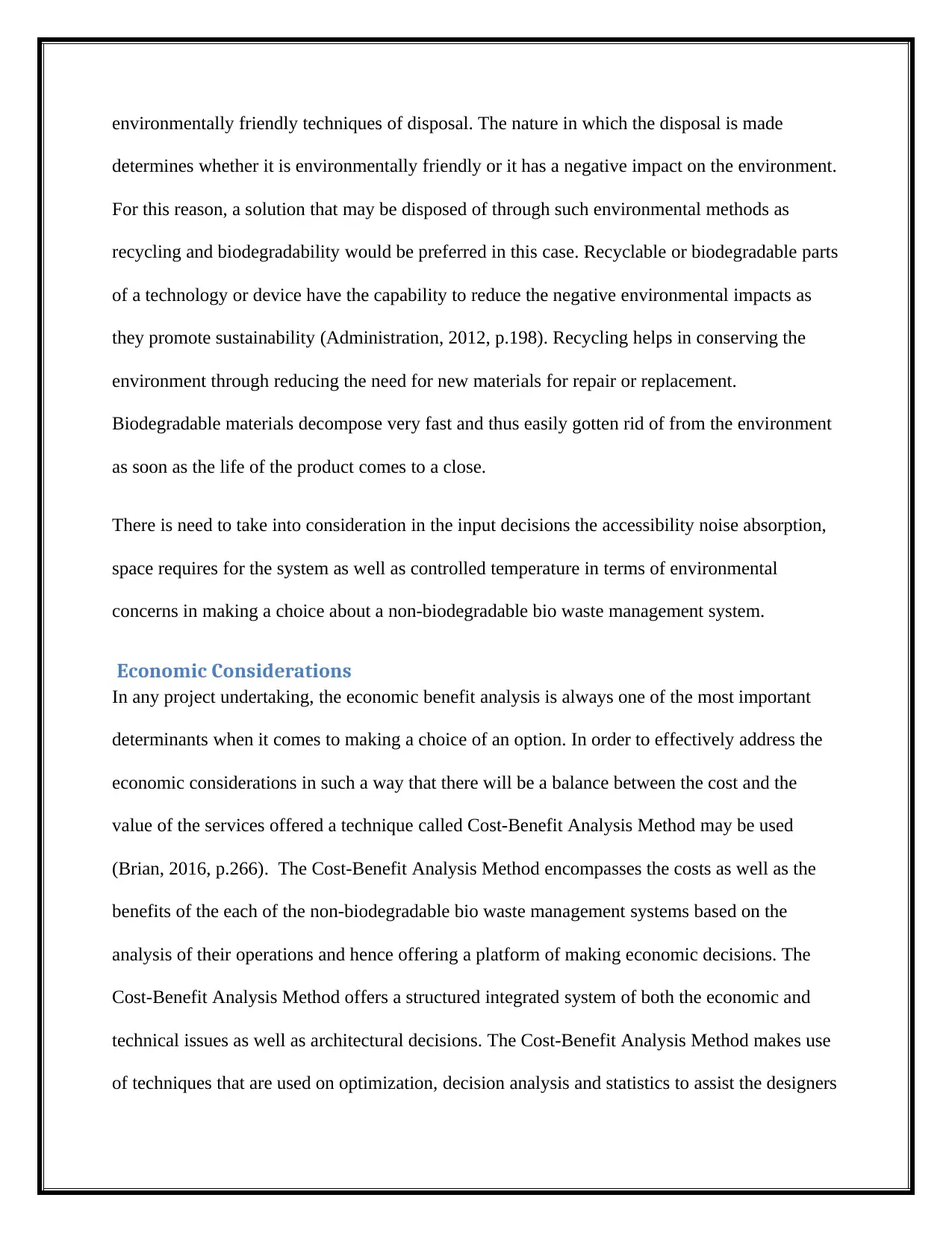
environmentally friendly techniques of disposal. The nature in which the disposal is made
determines whether it is environmentally friendly or it has a negative impact on the environment.
For this reason, a solution that may be disposed of through such environmental methods as
recycling and biodegradability would be preferred in this case. Recyclable or biodegradable parts
of a technology or device have the capability to reduce the negative environmental impacts as
they promote sustainability (Administration, 2012, p.198). Recycling helps in conserving the
environment through reducing the need for new materials for repair or replacement.
Biodegradable materials decompose very fast and thus easily gotten rid of from the environment
as soon as the life of the product comes to a close.
There is need to take into consideration in the input decisions the accessibility noise absorption,
space requires for the system as well as controlled temperature in terms of environmental
concerns in making a choice about a non-biodegradable bio waste management system.
Economic Considerations
In any project undertaking, the economic benefit analysis is always one of the most important
determinants when it comes to making a choice of an option. In order to effectively address the
economic considerations in such a way that there will be a balance between the cost and the
value of the services offered a technique called Cost-Benefit Analysis Method may be used
(Brian, 2016, p.266). The Cost-Benefit Analysis Method encompasses the costs as well as the
benefits of the each of the non-biodegradable bio waste management systems based on the
analysis of their operations and hence offering a platform of making economic decisions. The
Cost-Benefit Analysis Method offers a structured integrated system of both the economic and
technical issues as well as architectural decisions. The Cost-Benefit Analysis Method makes use
of techniques that are used on optimization, decision analysis and statistics to assist the designers
determines whether it is environmentally friendly or it has a negative impact on the environment.
For this reason, a solution that may be disposed of through such environmental methods as
recycling and biodegradability would be preferred in this case. Recyclable or biodegradable parts
of a technology or device have the capability to reduce the negative environmental impacts as
they promote sustainability (Administration, 2012, p.198). Recycling helps in conserving the
environment through reducing the need for new materials for repair or replacement.
Biodegradable materials decompose very fast and thus easily gotten rid of from the environment
as soon as the life of the product comes to a close.
There is need to take into consideration in the input decisions the accessibility noise absorption,
space requires for the system as well as controlled temperature in terms of environmental
concerns in making a choice about a non-biodegradable bio waste management system.
Economic Considerations
In any project undertaking, the economic benefit analysis is always one of the most important
determinants when it comes to making a choice of an option. In order to effectively address the
economic considerations in such a way that there will be a balance between the cost and the
value of the services offered a technique called Cost-Benefit Analysis Method may be used
(Brian, 2016, p.266). The Cost-Benefit Analysis Method encompasses the costs as well as the
benefits of the each of the non-biodegradable bio waste management systems based on the
analysis of their operations and hence offering a platform of making economic decisions. The
Cost-Benefit Analysis Method offers a structured integrated system of both the economic and
technical issues as well as architectural decisions. The Cost-Benefit Analysis Method makes use
of techniques that are used on optimization, decision analysis and statistics to assist the designers
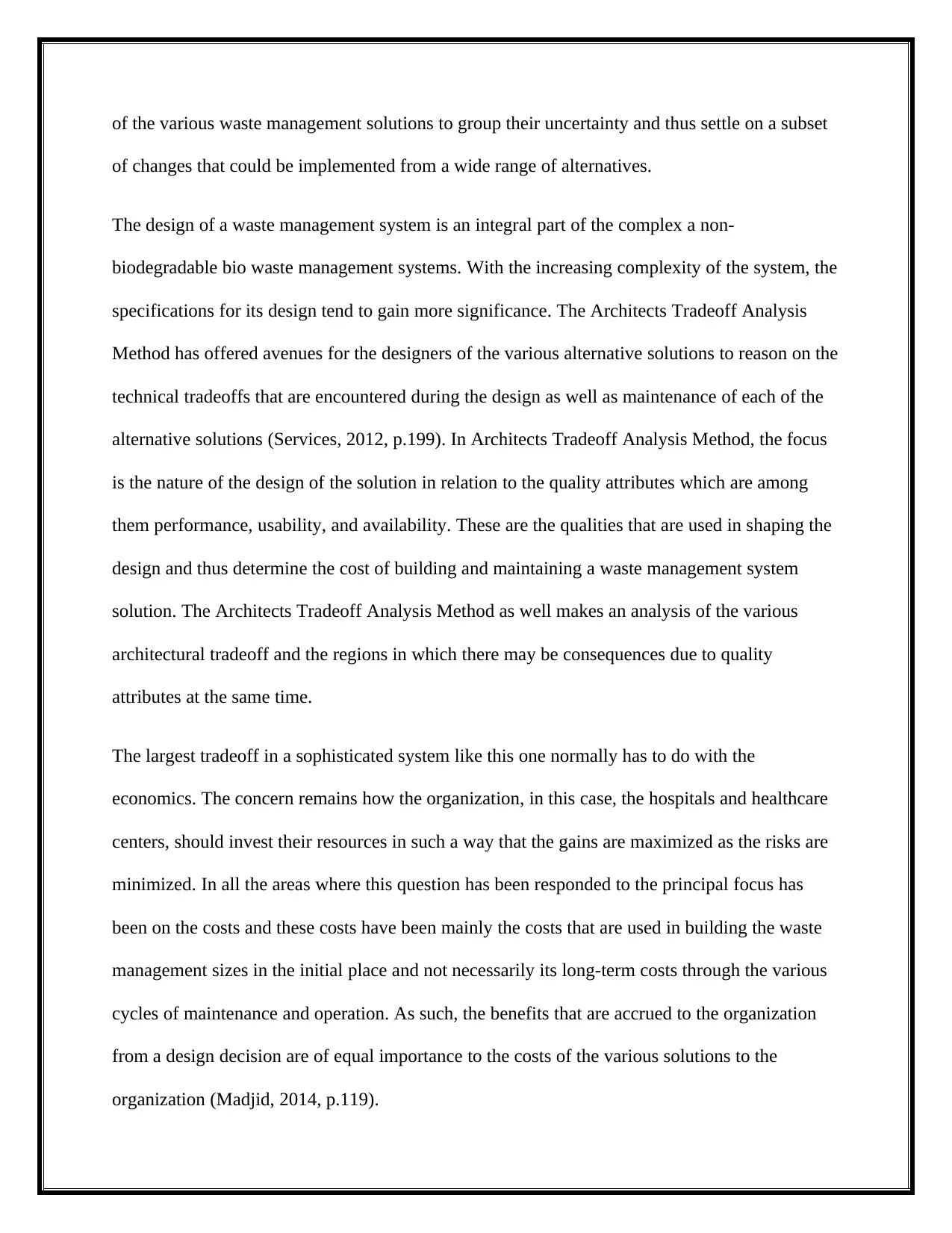
of the various waste management solutions to group their uncertainty and thus settle on a subset
of changes that could be implemented from a wide range of alternatives.
The design of a waste management system is an integral part of the complex a non-
biodegradable bio waste management systems. With the increasing complexity of the system, the
specifications for its design tend to gain more significance. The Architects Tradeoff Analysis
Method has offered avenues for the designers of the various alternative solutions to reason on the
technical tradeoffs that are encountered during the design as well as maintenance of each of the
alternative solutions (Services, 2012, p.199). In Architects Tradeoff Analysis Method, the focus
is the nature of the design of the solution in relation to the quality attributes which are among
them performance, usability, and availability. These are the qualities that are used in shaping the
design and thus determine the cost of building and maintaining a waste management system
solution. The Architects Tradeoff Analysis Method as well makes an analysis of the various
architectural tradeoff and the regions in which there may be consequences due to quality
attributes at the same time.
The largest tradeoff in a sophisticated system like this one normally has to do with the
economics. The concern remains how the organization, in this case, the hospitals and healthcare
centers, should invest their resources in such a way that the gains are maximized as the risks are
minimized. In all the areas where this question has been responded to the principal focus has
been on the costs and these costs have been mainly the costs that are used in building the waste
management sizes in the initial place and not necessarily its long-term costs through the various
cycles of maintenance and operation. As such, the benefits that are accrued to the organization
from a design decision are of equal importance to the costs of the various solutions to the
organization (Madjid, 2014, p.119).
of changes that could be implemented from a wide range of alternatives.
The design of a waste management system is an integral part of the complex a non-
biodegradable bio waste management systems. With the increasing complexity of the system, the
specifications for its design tend to gain more significance. The Architects Tradeoff Analysis
Method has offered avenues for the designers of the various alternative solutions to reason on the
technical tradeoffs that are encountered during the design as well as maintenance of each of the
alternative solutions (Services, 2012, p.199). In Architects Tradeoff Analysis Method, the focus
is the nature of the design of the solution in relation to the quality attributes which are among
them performance, usability, and availability. These are the qualities that are used in shaping the
design and thus determine the cost of building and maintaining a waste management system
solution. The Architects Tradeoff Analysis Method as well makes an analysis of the various
architectural tradeoff and the regions in which there may be consequences due to quality
attributes at the same time.
The largest tradeoff in a sophisticated system like this one normally has to do with the
economics. The concern remains how the organization, in this case, the hospitals and healthcare
centers, should invest their resources in such a way that the gains are maximized as the risks are
minimized. In all the areas where this question has been responded to the principal focus has
been on the costs and these costs have been mainly the costs that are used in building the waste
management sizes in the initial place and not necessarily its long-term costs through the various
cycles of maintenance and operation. As such, the benefits that are accrued to the organization
from a design decision are of equal importance to the costs of the various solutions to the
organization (Madjid, 2014, p.119).
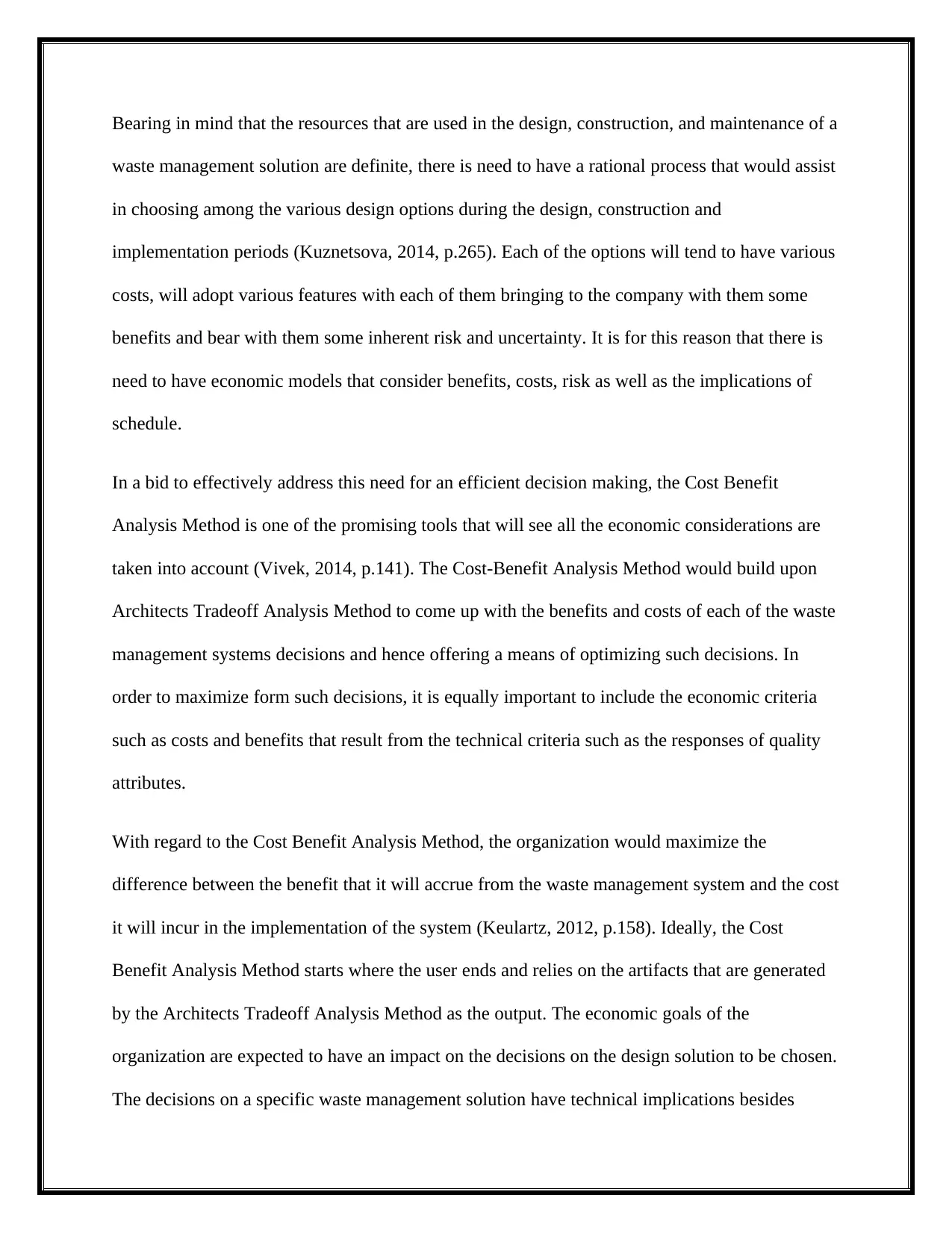
Bearing in mind that the resources that are used in the design, construction, and maintenance of a
waste management solution are definite, there is need to have a rational process that would assist
in choosing among the various design options during the design, construction and
implementation periods (Kuznetsova, 2014, p.265). Each of the options will tend to have various
costs, will adopt various features with each of them bringing to the company with them some
benefits and bear with them some inherent risk and uncertainty. It is for this reason that there is
need to have economic models that consider benefits, costs, risk as well as the implications of
schedule.
In a bid to effectively address this need for an efficient decision making, the Cost Benefit
Analysis Method is one of the promising tools that will see all the economic considerations are
taken into account (Vivek, 2014, p.141). The Cost-Benefit Analysis Method would build upon
Architects Tradeoff Analysis Method to come up with the benefits and costs of each of the waste
management systems decisions and hence offering a means of optimizing such decisions. In
order to maximize form such decisions, it is equally important to include the economic criteria
such as costs and benefits that result from the technical criteria such as the responses of quality
attributes.
With regard to the Cost Benefit Analysis Method, the organization would maximize the
difference between the benefit that it will accrue from the waste management system and the cost
it will incur in the implementation of the system (Keulartz, 2012, p.158). Ideally, the Cost
Benefit Analysis Method starts where the user ends and relies on the artifacts that are generated
by the Architects Tradeoff Analysis Method as the output. The economic goals of the
organization are expected to have an impact on the decisions on the design solution to be chosen.
The decisions on a specific waste management solution have technical implications besides
waste management solution are definite, there is need to have a rational process that would assist
in choosing among the various design options during the design, construction and
implementation periods (Kuznetsova, 2014, p.265). Each of the options will tend to have various
costs, will adopt various features with each of them bringing to the company with them some
benefits and bear with them some inherent risk and uncertainty. It is for this reason that there is
need to have economic models that consider benefits, costs, risk as well as the implications of
schedule.
In a bid to effectively address this need for an efficient decision making, the Cost Benefit
Analysis Method is one of the promising tools that will see all the economic considerations are
taken into account (Vivek, 2014, p.141). The Cost-Benefit Analysis Method would build upon
Architects Tradeoff Analysis Method to come up with the benefits and costs of each of the waste
management systems decisions and hence offering a means of optimizing such decisions. In
order to maximize form such decisions, it is equally important to include the economic criteria
such as costs and benefits that result from the technical criteria such as the responses of quality
attributes.
With regard to the Cost Benefit Analysis Method, the organization would maximize the
difference between the benefit that it will accrue from the waste management system and the cost
it will incur in the implementation of the system (Keulartz, 2012, p.158). Ideally, the Cost
Benefit Analysis Method starts where the user ends and relies on the artifacts that are generated
by the Architects Tradeoff Analysis Method as the output. The economic goals of the
organization are expected to have an impact on the decisions on the design solution to be chosen.
The decisions on a specific waste management solution have technical implications besides
Secure Best Marks with AI Grader
Need help grading? Try our AI Grader for instant feedback on your assignments.
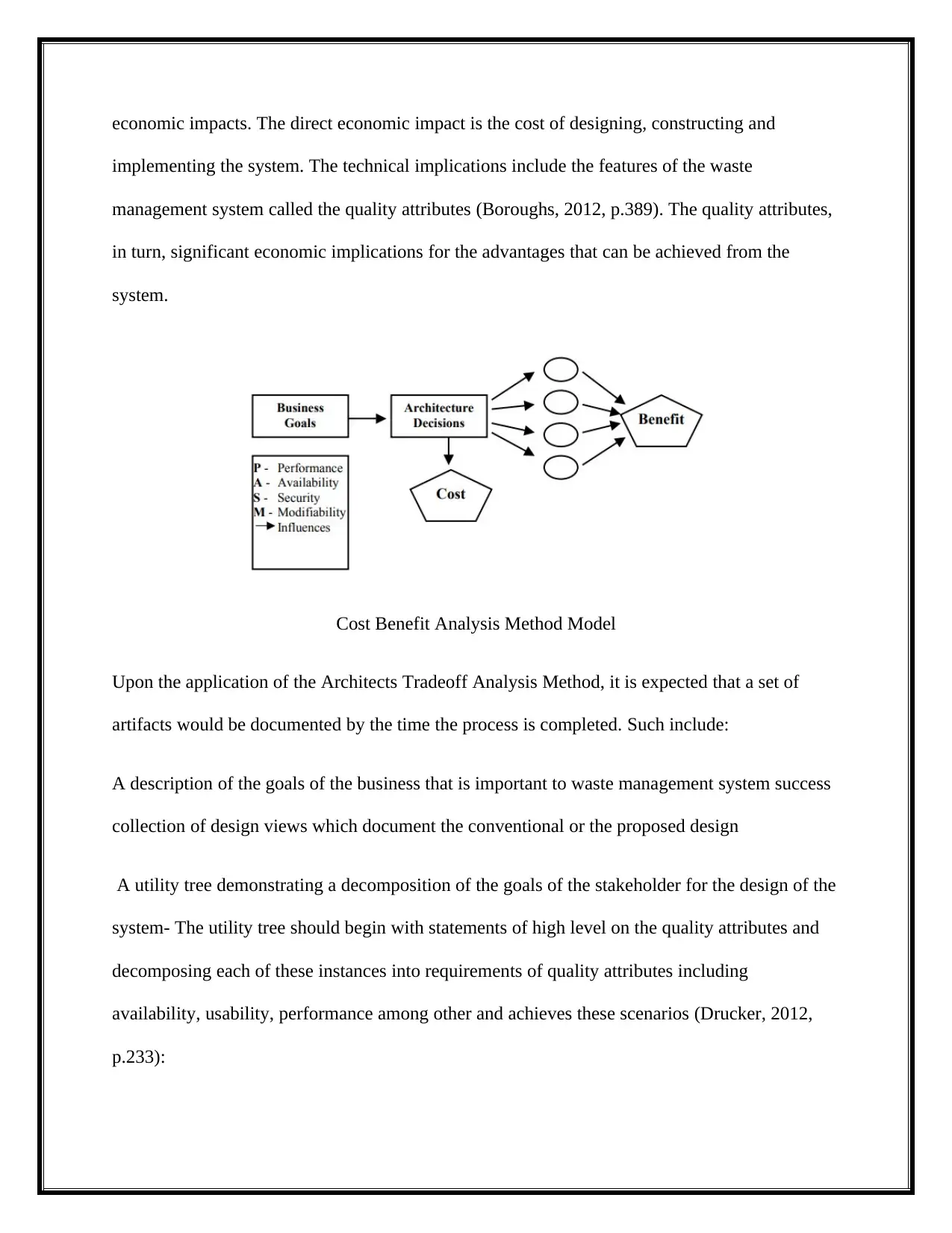
economic impacts. The direct economic impact is the cost of designing, constructing and
implementing the system. The technical implications include the features of the waste
management system called the quality attributes (Boroughs, 2012, p.389). The quality attributes,
in turn, significant economic implications for the advantages that can be achieved from the
system.
Cost Benefit Analysis Method Model
Upon the application of the Architects Tradeoff Analysis Method, it is expected that a set of
artifacts would be documented by the time the process is completed. Such include:
A description of the goals of the business that is important to waste management system success
collection of design views which document the conventional or the proposed design
A utility tree demonstrating a decomposition of the goals of the stakeholder for the design of the
system- The utility tree should begin with statements of high level on the quality attributes and
decomposing each of these instances into requirements of quality attributes including
availability, usability, performance among other and achieves these scenarios (Drucker, 2012,
p.233):
implementing the system. The technical implications include the features of the waste
management system called the quality attributes (Boroughs, 2012, p.389). The quality attributes,
in turn, significant economic implications for the advantages that can be achieved from the
system.
Cost Benefit Analysis Method Model
Upon the application of the Architects Tradeoff Analysis Method, it is expected that a set of
artifacts would be documented by the time the process is completed. Such include:
A description of the goals of the business that is important to waste management system success
collection of design views which document the conventional or the proposed design
A utility tree demonstrating a decomposition of the goals of the stakeholder for the design of the
system- The utility tree should begin with statements of high level on the quality attributes and
decomposing each of these instances into requirements of quality attributes including
availability, usability, performance among other and achieves these scenarios (Drucker, 2012,
p.233):

A set of the identified risks
The sensitivity points which include the design decisions that have an impact on more
one quality attribute measure of concern (Douglas, 2017, p.175).
A collection of the tradeoff points which include the architectural decisions that have
impacts on more than a single quality attributes measure some being positive and others
negative.
The Architects Tradeoff Analysis Method results in a set of design decisions that have the
potential to be problematic following the quality attribute scenario that has elicited from the
various stakeholders. These design decisions lead to some definite quality attribute responses
among them security, performance levels, usability and modifiability among other attributes. It
should not be forgotten that these design decisions as well have accompanying costs for example
in case a design decision is such that it is meant to make use of redundant hardware in increasing
the reliability, then such has cost implications (Boroughs, 2012, p.178). Any design decisions
will have a measurable reliability level may be measured in terms of mean time to failure or
availability of steady state. The responses of the quality attributes will attach value to the
organization that is implementing the waste management system.
Quantification and Costing
A single design strategy or solution has an effect on more than one quality attribute with some of
the effects being negative and others positive all of which are varying in degrees. The actual
effects of a particular design may not easily be identified in the case of a large waste
management system. In as much as some of the variations are measurable through the use of
simulation models, some of the effects caused by changes may be realized through elicitation of
the experts who are tow work with the system and their comprehension of how the system
The sensitivity points which include the design decisions that have an impact on more
one quality attribute measure of concern (Douglas, 2017, p.175).
A collection of the tradeoff points which include the architectural decisions that have
impacts on more than a single quality attributes measure some being positive and others
negative.
The Architects Tradeoff Analysis Method results in a set of design decisions that have the
potential to be problematic following the quality attribute scenario that has elicited from the
various stakeholders. These design decisions lead to some definite quality attribute responses
among them security, performance levels, usability and modifiability among other attributes. It
should not be forgotten that these design decisions as well have accompanying costs for example
in case a design decision is such that it is meant to make use of redundant hardware in increasing
the reliability, then such has cost implications (Boroughs, 2012, p.178). Any design decisions
will have a measurable reliability level may be measured in terms of mean time to failure or
availability of steady state. The responses of the quality attributes will attach value to the
organization that is implementing the waste management system.
Quantification and Costing
A single design strategy or solution has an effect on more than one quality attribute with some of
the effects being negative and others positive all of which are varying in degrees. The actual
effects of a particular design may not easily be identified in the case of a large waste
management system. In as much as some of the variations are measurable through the use of
simulation models, some of the effects caused by changes may be realized through elicitation of
the experts who are tow work with the system and their comprehension of how the system
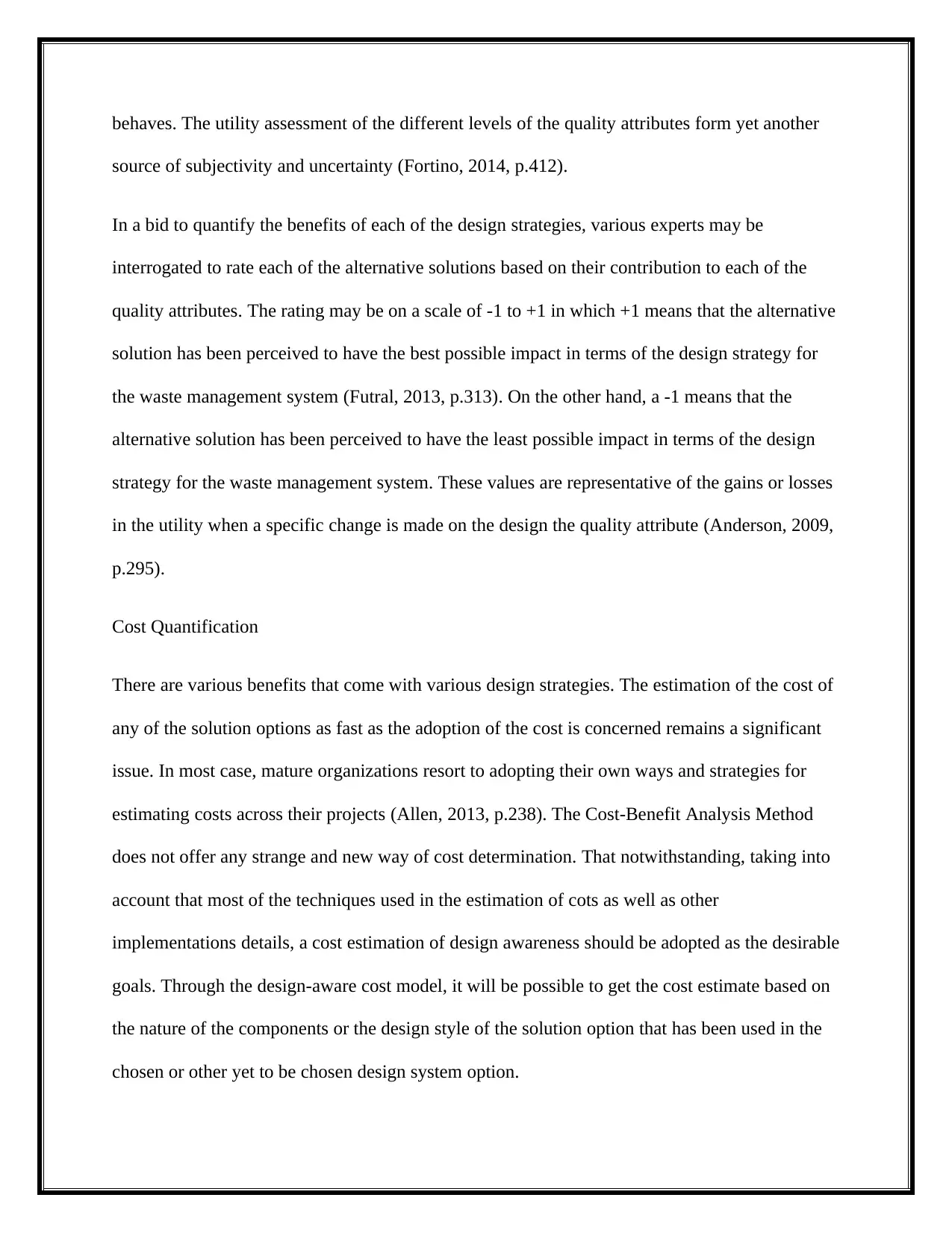
behaves. The utility assessment of the different levels of the quality attributes form yet another
source of subjectivity and uncertainty (Fortino, 2014, p.412).
In a bid to quantify the benefits of each of the design strategies, various experts may be
interrogated to rate each of the alternative solutions based on their contribution to each of the
quality attributes. The rating may be on a scale of -1 to +1 in which +1 means that the alternative
solution has been perceived to have the best possible impact in terms of the design strategy for
the waste management system (Futral, 2013, p.313). On the other hand, a -1 means that the
alternative solution has been perceived to have the least possible impact in terms of the design
strategy for the waste management system. These values are representative of the gains or losses
in the utility when a specific change is made on the design the quality attribute (Anderson, 2009,
p.295).
Cost Quantification
There are various benefits that come with various design strategies. The estimation of the cost of
any of the solution options as fast as the adoption of the cost is concerned remains a significant
issue. In most case, mature organizations resort to adopting their own ways and strategies for
estimating costs across their projects (Allen, 2013, p.238). The Cost-Benefit Analysis Method
does not offer any strange and new way of cost determination. That notwithstanding, taking into
account that most of the techniques used in the estimation of cots as well as other
implementations details, a cost estimation of design awareness should be adopted as the desirable
goals. Through the design-aware cost model, it will be possible to get the cost estimate based on
the nature of the components or the design style of the solution option that has been used in the
chosen or other yet to be chosen design system option.
source of subjectivity and uncertainty (Fortino, 2014, p.412).
In a bid to quantify the benefits of each of the design strategies, various experts may be
interrogated to rate each of the alternative solutions based on their contribution to each of the
quality attributes. The rating may be on a scale of -1 to +1 in which +1 means that the alternative
solution has been perceived to have the best possible impact in terms of the design strategy for
the waste management system (Futral, 2013, p.313). On the other hand, a -1 means that the
alternative solution has been perceived to have the least possible impact in terms of the design
strategy for the waste management system. These values are representative of the gains or losses
in the utility when a specific change is made on the design the quality attribute (Anderson, 2009,
p.295).
Cost Quantification
There are various benefits that come with various design strategies. The estimation of the cost of
any of the solution options as fast as the adoption of the cost is concerned remains a significant
issue. In most case, mature organizations resort to adopting their own ways and strategies for
estimating costs across their projects (Allen, 2013, p.238). The Cost-Benefit Analysis Method
does not offer any strange and new way of cost determination. That notwithstanding, taking into
account that most of the techniques used in the estimation of cots as well as other
implementations details, a cost estimation of design awareness should be adopted as the desirable
goals. Through the design-aware cost model, it will be possible to get the cost estimate based on
the nature of the components or the design style of the solution option that has been used in the
chosen or other yet to be chosen design system option.
Paraphrase This Document
Need a fresh take? Get an instant paraphrase of this document with our AI Paraphraser

Currently, Cost-Benefit Analysis Method assumed that there are already methods of cost
estimation that are available in the organization from which it is possible to obtain the cost
estimates directly for each of the design strategies of the wide range of solution options (Jones,
2014, p.214). Besides eliciting the benefits and costs of the design strategy in each of the
solution options that are being considered, it is fundamentally important to approximate the
schedule implications of each of the design strategies with regard to the time elapse, the levels of
dependency among the efforts used in implementation and shared use of very important
resources. Maybe a design strategy could otherwise turn out to be undesirable and is not fitting
the time-to-market goals of the organization (Administration, 2012, p.118). At this stage, the
note will be taken on any contentious issue with the shared resources among the estimates. Such
resources include the hardware and the personnel among other resources for they also have an
impact on the feasibility of a design strategy.
estimation that are available in the organization from which it is possible to obtain the cost
estimates directly for each of the design strategies of the wide range of solution options (Jones,
2014, p.214). Besides eliciting the benefits and costs of the design strategy in each of the
solution options that are being considered, it is fundamentally important to approximate the
schedule implications of each of the design strategies with regard to the time elapse, the levels of
dependency among the efforts used in implementation and shared use of very important
resources. Maybe a design strategy could otherwise turn out to be undesirable and is not fitting
the time-to-market goals of the organization (Administration, 2012, p.118). At this stage, the
note will be taken on any contentious issue with the shared resources among the estimates. Such
resources include the hardware and the personnel among other resources for they also have an
impact on the feasibility of a design strategy.

5. References
Administration, F.H., 2012. Special Mixture Design Considerations and Methods for Warm Mix
Asphalt: A Supplement to NCHRP Report 673, A Manual for Design of Hot Mix Asphalt with
Commentary. 5th ed. New York: Transportation Research Board.
Allen, J.M., 2013. Technology Solutions for Today's Lawyer. 5th ed. New York: American Bar
Association.
Anderson, G., 2009. SAP Implementation Unleashed: A Business and Technical Roadmap to
Deploying SAP. 4th ed. New York: Sams Publishing.
Boroughs, M.A., 2012. Using Technology to Create Value: Designing the Tools for the New HR
Function. 7th ed. London: Gower Publishing, Ltd.
Brian, D., 2016. Space and Organizational Considerations in Academic Library Partnerships
and Collaboration. 3rd ed. London: IGI Global.
Douglas, I., 2017. End-User Considerations in Educational Technology Design. 7th ed.
Manchester: IGI Global.
Drucker, a.J., 2012. Technology Tools for Today's High-Margin Practice: How Client-Centered
Financial Advisors Can Cut Paperwork, Overhead, and Wasted Hours. 2nd ed. Oxford: John
Wiley & Sons.
Fortino, G., 2014. internet of Things Based on Smart Objects: Technology, Middleware, and
Applications. 4th ed. London: Springer Science & Business Media.
Futral, W., 2013. Intel® Trusted Execution Technology for Server Platforms: A Guide to More
Secure Datacenters. 12th ed. New York: Apress.
Administration, F.H., 2012. Special Mixture Design Considerations and Methods for Warm Mix
Asphalt: A Supplement to NCHRP Report 673, A Manual for Design of Hot Mix Asphalt with
Commentary. 5th ed. New York: Transportation Research Board.
Allen, J.M., 2013. Technology Solutions for Today's Lawyer. 5th ed. New York: American Bar
Association.
Anderson, G., 2009. SAP Implementation Unleashed: A Business and Technical Roadmap to
Deploying SAP. 4th ed. New York: Sams Publishing.
Boroughs, M.A., 2012. Using Technology to Create Value: Designing the Tools for the New HR
Function. 7th ed. London: Gower Publishing, Ltd.
Brian, D., 2016. Space and Organizational Considerations in Academic Library Partnerships
and Collaboration. 3rd ed. London: IGI Global.
Douglas, I., 2017. End-User Considerations in Educational Technology Design. 7th ed.
Manchester: IGI Global.
Drucker, a.J., 2012. Technology Tools for Today's High-Margin Practice: How Client-Centered
Financial Advisors Can Cut Paperwork, Overhead, and Wasted Hours. 2nd ed. Oxford: John
Wiley & Sons.
Fortino, G., 2014. internet of Things Based on Smart Objects: Technology, Middleware, and
Applications. 4th ed. London: Springer Science & Business Media.
Futral, W., 2013. Intel® Trusted Execution Technology for Server Platforms: A Guide to More
Secure Datacenters. 12th ed. New York: Apress.
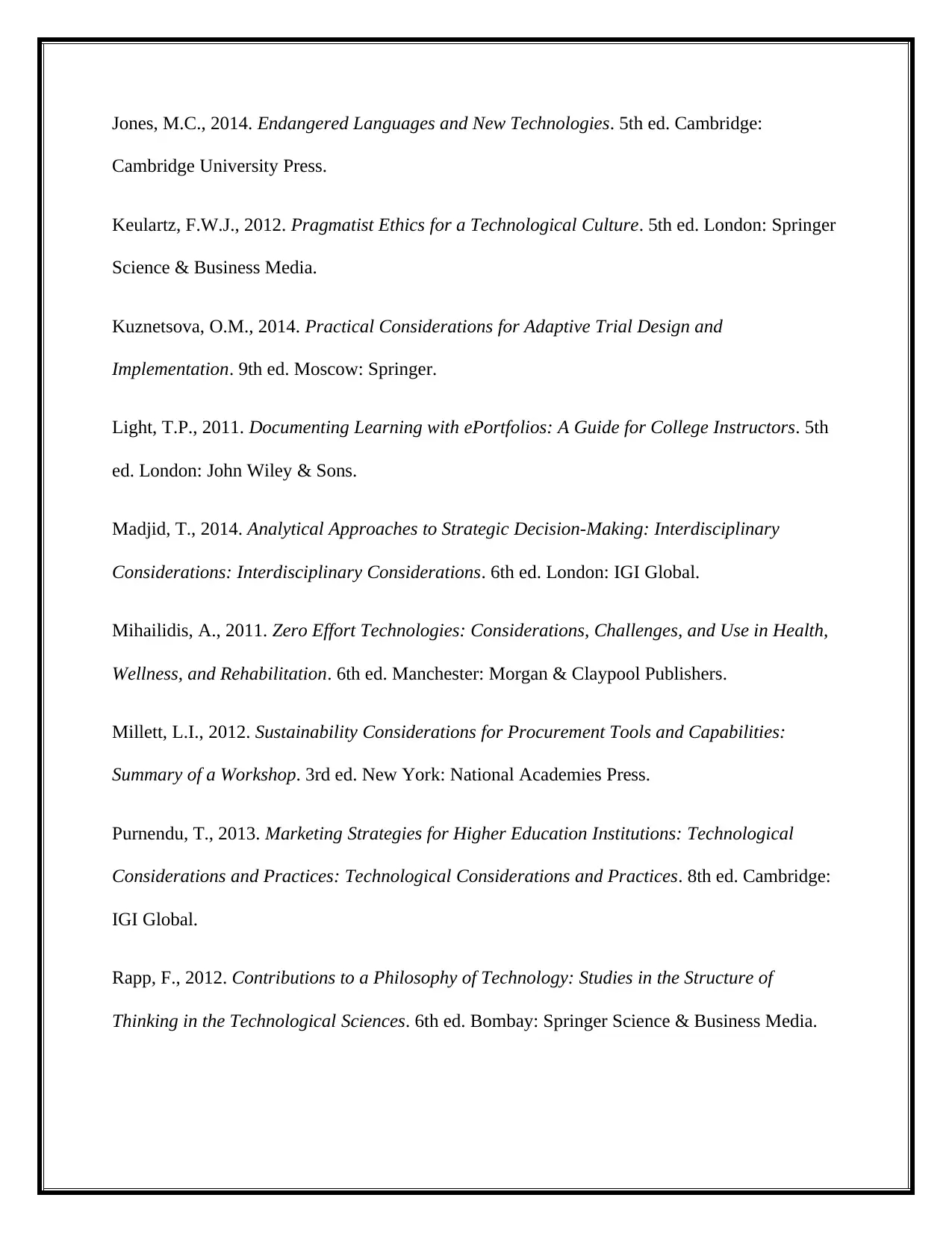
Jones, M.C., 2014. Endangered Languages and New Technologies. 5th ed. Cambridge:
Cambridge University Press.
Keulartz, F.W.J., 2012. Pragmatist Ethics for a Technological Culture. 5th ed. London: Springer
Science & Business Media.
Kuznetsova, O.M., 2014. Practical Considerations for Adaptive Trial Design and
Implementation. 9th ed. Moscow: Springer.
Light, T.P., 2011. Documenting Learning with ePortfolios: A Guide for College Instructors. 5th
ed. London: John Wiley & Sons.
Madjid, T., 2014. Analytical Approaches to Strategic Decision-Making: Interdisciplinary
Considerations: Interdisciplinary Considerations. 6th ed. London: IGI Global.
Mihailidis, A., 2011. Zero Effort Technologies: Considerations, Challenges, and Use in Health,
Wellness, and Rehabilitation. 6th ed. Manchester: Morgan & Claypool Publishers.
Millett, L.I., 2012. Sustainability Considerations for Procurement Tools and Capabilities:
Summary of a Workshop. 3rd ed. New York: National Academies Press.
Purnendu, T., 2013. Marketing Strategies for Higher Education Institutions: Technological
Considerations and Practices: Technological Considerations and Practices. 8th ed. Cambridge:
IGI Global.
Rapp, F., 2012. Contributions to a Philosophy of Technology: Studies in the Structure of
Thinking in the Technological Sciences. 6th ed. Bombay: Springer Science & Business Media.
Cambridge University Press.
Keulartz, F.W.J., 2012. Pragmatist Ethics for a Technological Culture. 5th ed. London: Springer
Science & Business Media.
Kuznetsova, O.M., 2014. Practical Considerations for Adaptive Trial Design and
Implementation. 9th ed. Moscow: Springer.
Light, T.P., 2011. Documenting Learning with ePortfolios: A Guide for College Instructors. 5th
ed. London: John Wiley & Sons.
Madjid, T., 2014. Analytical Approaches to Strategic Decision-Making: Interdisciplinary
Considerations: Interdisciplinary Considerations. 6th ed. London: IGI Global.
Mihailidis, A., 2011. Zero Effort Technologies: Considerations, Challenges, and Use in Health,
Wellness, and Rehabilitation. 6th ed. Manchester: Morgan & Claypool Publishers.
Millett, L.I., 2012. Sustainability Considerations for Procurement Tools and Capabilities:
Summary of a Workshop. 3rd ed. New York: National Academies Press.
Purnendu, T., 2013. Marketing Strategies for Higher Education Institutions: Technological
Considerations and Practices: Technological Considerations and Practices. 8th ed. Cambridge:
IGI Global.
Rapp, F., 2012. Contributions to a Philosophy of Technology: Studies in the Structure of
Thinking in the Technological Sciences. 6th ed. Bombay: Springer Science & Business Media.
Secure Best Marks with AI Grader
Need help grading? Try our AI Grader for instant feedback on your assignments.
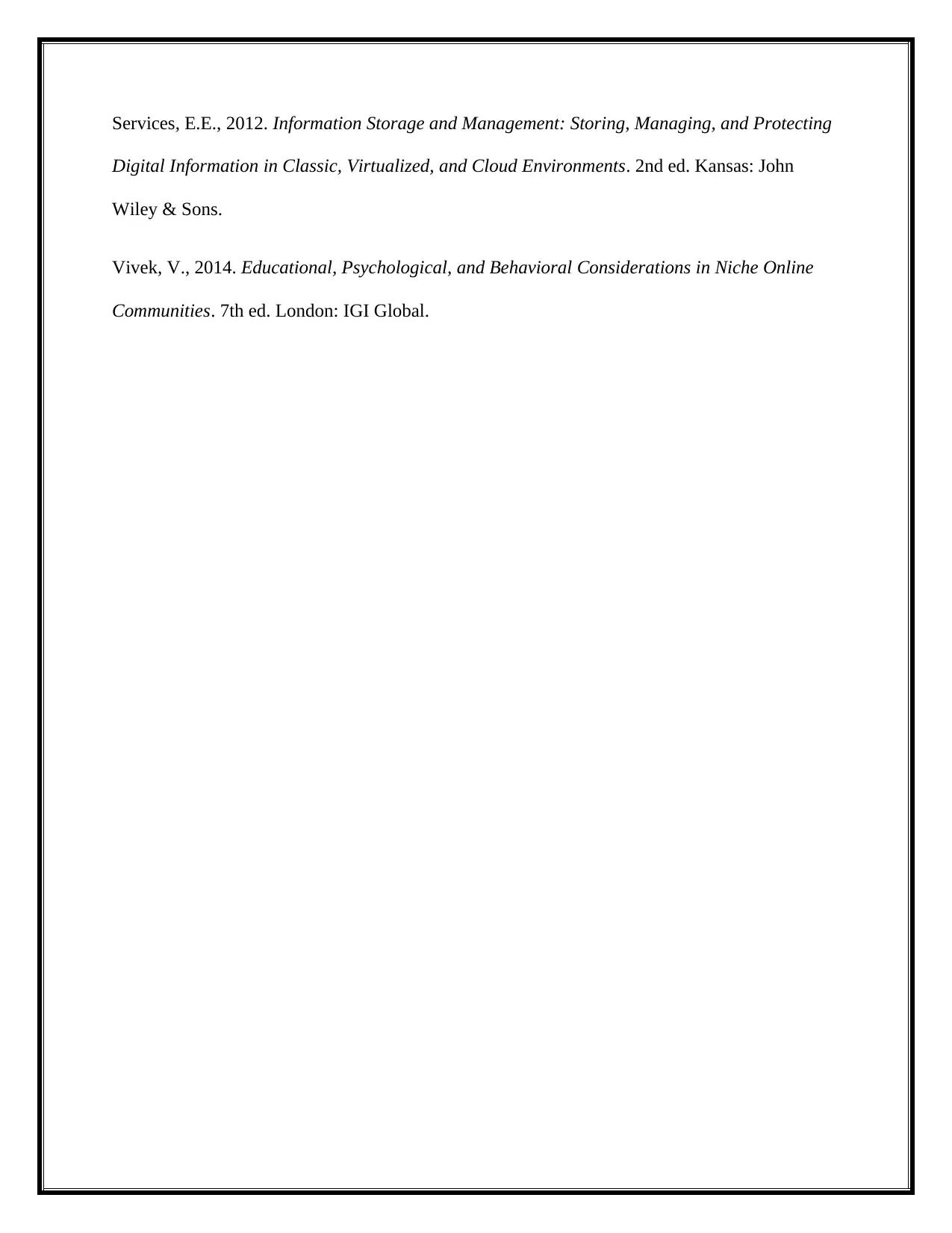
Services, E.E., 2012. Information Storage and Management: Storing, Managing, and Protecting
Digital Information in Classic, Virtualized, and Cloud Environments. 2nd ed. Kansas: John
Wiley & Sons.
Vivek, V., 2014. Educational, Psychological, and Behavioral Considerations in Niche Online
Communities. 7th ed. London: IGI Global.
Digital Information in Classic, Virtualized, and Cloud Environments. 2nd ed. Kansas: John
Wiley & Sons.
Vivek, V., 2014. Educational, Psychological, and Behavioral Considerations in Niche Online
Communities. 7th ed. London: IGI Global.
1 out of 23
Related Documents
Your All-in-One AI-Powered Toolkit for Academic Success.
+13062052269
info@desklib.com
Available 24*7 on WhatsApp / Email
![[object Object]](/_next/static/media/star-bottom.7253800d.svg)
Unlock your academic potential
© 2024 | Zucol Services PVT LTD | All rights reserved.





